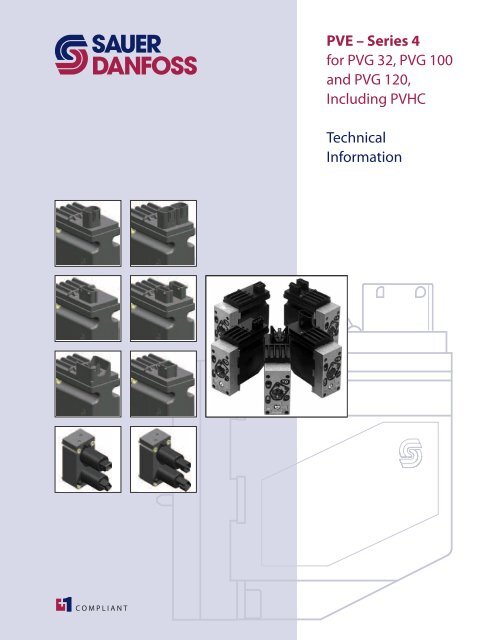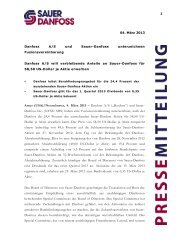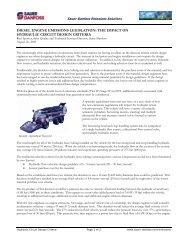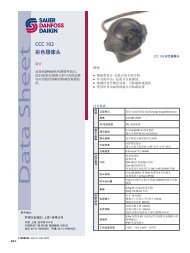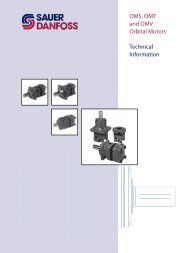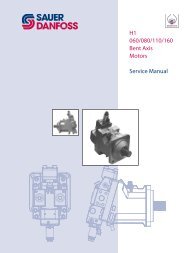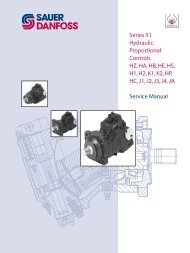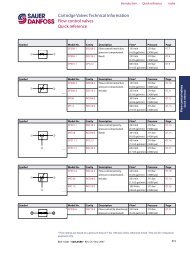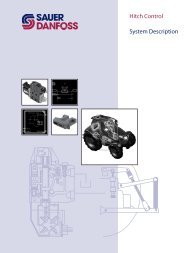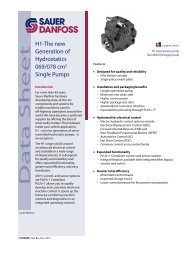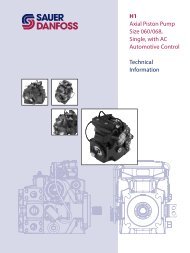PVE â Series 4 for PVG 32, PVG 100 and PVG 120 ... - Sauer-Danfoss
PVE â Series 4 for PVG 32, PVG 100 and PVG 120 ... - Sauer-Danfoss
PVE â Series 4 for PVG 32, PVG 100 and PVG 120 ... - Sauer-Danfoss
Create successful ePaper yourself
Turn your PDF publications into a flip-book with our unique Google optimized e-Paper software.
<strong>PVE</strong> – <strong>Series</strong> 4<br />
<strong>for</strong> <strong>PVG</strong> <strong>32</strong>, <strong>PVG</strong> <strong>100</strong><br />
<strong>and</strong> <strong>PVG</strong> <strong>120</strong>,<br />
Including PVHC<br />
Technical<br />
In<strong>for</strong>mation
2 520L0553 • Rev GB • Aug 2012<br />
<strong>PVE</strong> <strong>Series</strong> 4 <strong>for</strong> <strong>PVG</strong> <strong>32</strong>, <strong>PVG</strong> <strong>100</strong> <strong>and</strong> <strong>PVG</strong> <strong>120</strong>, Including PVHC<br />
Technical In<strong>for</strong>mation<br />
Revisions, Abbreviations<br />
Revision History Table of Revisions<br />
Date Page Changed Rev<br />
Jun 2011 All Major update FA<br />
Jan 2012 44-45 Various changes FB<br />
May 2012 All Major update GA<br />
Aug 2012 All Various, new articles about -NP, 1 page more moved all. GB<br />
List of Abbreviations Abbreviation Description<br />
ASIC Application Specific Integrated Circuit - the part of the <strong>PVE</strong> where spool position is<br />
controled to follow setpoint<br />
ATEX Certificated <strong>for</strong> use in flammable environment<br />
AVC Auxillery Valve Com<strong>and</strong> - ISOBUS/J1939 st<strong>and</strong>ard signal <strong>for</strong> valve control<br />
AVCTO Auxillery Valve Com<strong>and</strong> Time Out - Fault monitoring setting<br />
AVEF Auxillery Valve Estimated Flow - ISOBUS/J1939 st<strong>and</strong>ard signal <strong>for</strong> valve feedback<br />
CAN Controller Area Network - Communication method used by <strong>PVE</strong>D<br />
CLC Closed Loop Circuit<br />
CRC Cyclic Redundancy Check - Method <strong>for</strong> ensuring validity of data.<br />
-DI <strong>PVE</strong> with Direction Indication<br />
DM1 Diagnostic Message 1 - J1939 message in<strong>for</strong>ming about present fault<br />
DM2 Diagnostic Message 2 - J1939 message in<strong>for</strong>ming about fault history<br />
DM3 Diagnostic Message 3 - J1939 message clearing fault history<br />
DSM Device State Machine. Deterministic description of system process<br />
ECU Electronic Control Unit<br />
EH Electro Hydraulic<br />
-F <strong>PVE</strong> <strong>for</strong> Float spool. Two variants: 4 pin with float at 75%. 6 pin with separate float.<br />
FMEA Failure Mode Effect Analysis<br />
ISOBUS Communication st<strong>and</strong>ard <strong>for</strong> CAN<br />
J1939 Communication st<strong>and</strong>ard <strong>for</strong> CAN<br />
LED Light Emitting Diode<br />
LS Load Sensing<br />
LVDT Linear Variable Differential Transducer - Position sensor<br />
NC Normally Closed solenoid valve in <strong>PVE</strong><br />
NC-H Normally Closed st<strong>and</strong>ard solenoid valve - like in <strong>PVE</strong>H<br />
NC-S Normally Closed solenoid valve Super - like in <strong>PVE</strong>S<br />
NO Normally Open solenoid valve in <strong>PVE</strong><br />
© 2012 <strong>Sauer</strong>-<strong>Danfoss</strong>. All rights reserved.<br />
<strong>Sauer</strong>-<strong>Danfoss</strong> accepts no responsibility <strong>for</strong> possible errors in catalogs, brochures <strong>and</strong> other printed material.<br />
<strong>Sauer</strong> -<strong>Danfoss</strong> reserves the right to alter its products without prior notice. This also applies to products already<br />
ordered provided that such alterations can be made without affecting agreed specifications. All trademarks<br />
in this material are properties of their respective owners. <strong>Sauer</strong>-<strong>Danfoss</strong>, the <strong>Sauer</strong>-<strong>Danfoss</strong> logotype, the<br />
<strong>Sauer</strong>-<strong>Danfoss</strong> S-icon, PLUS+1, What really matters is inside® <strong>and</strong> Know-How in Motion are trademarks of the<br />
<strong>Sauer</strong>-<strong>Danfoss</strong> Group.<br />
Front cover illustrations:V310299, V310300, V310294, V310292 ,V310295, V310291, F300704, drawing 157-506.
<strong>PVE</strong> <strong>Series</strong> 4 <strong>for</strong> <strong>PVG</strong> <strong>32</strong>, <strong>PVG</strong> <strong>100</strong> <strong>and</strong> <strong>PVG</strong> <strong>120</strong>, Including PVHC<br />
Technical In<strong>for</strong>mation<br />
Revisions, Abbreviations<br />
List of Abbreviations<br />
Abbreviation Description<br />
(continued) PLC Programmable Logical Circuit<br />
PLUS+1 Trademark <strong>for</strong> <strong>Sauer</strong>-<strong>Danfoss</strong> controllers <strong>and</strong> programming tool<br />
POST Power On Self Test. Boot up evaluation <strong>for</strong> <strong>PVE</strong>D<br />
Pp Pilot Pressure. The oil gallery <strong>for</strong> <strong>PVE</strong> actuation<br />
PVB Proportional Valve Basic module - valve slice<br />
PVBS Proportional Valve Basic module Spool<br />
PVBZ Proportional Valve Basic module Zero leakage<br />
<strong>PVE</strong> Proportional Valve Electric actuator<br />
<strong>PVE</strong>A <strong>PVE</strong> variant with 2-6 % hysteresis<br />
<strong>PVE</strong>D <strong>PVE</strong> variant Digital controlled via CAN communication<br />
<strong>PVE</strong>H <strong>PVE</strong> variant with 4-9% Hysteresis<br />
<strong>PVE</strong>M <strong>PVE</strong> variant with 25-35% hysteresis<br />
<strong>PVE</strong>O <strong>PVE</strong> variant with ON/OFF actuation<br />
<strong>PVE</strong>P <strong>PVE</strong> variant PWM controled<br />
<strong>PVE</strong>S <strong>PVE</strong> variant with 0-2% hysteresis<br />
<strong>PVE</strong>U <strong>PVE</strong> variant with U 0-10V<br />
S<br />
<strong>PVG</strong> Proportional multi-section Valve Group<br />
PVHC PV variant with Current controlled valve actuator<br />
PVM Proportional Valve Manual control with h<strong>and</strong>le<br />
PVP Proportional Valve Pump side module.Inlet<br />
PVS Proportional Valve end plate<br />
PVSK Proportional Valve end plate crane. Inlet module with Spool Control<br />
PWM Pulse Width Modulation<br />
S4 DJ <strong>Series</strong> 4 Digital J1939 service tool software <strong>for</strong> <strong>PVE</strong>D-CC<br />
SAE Society Automotive Engineering<br />
-R <strong>PVE</strong> with Ramp function<br />
-NP <strong>PVE</strong> with solenoid disable in Neutral Position<br />
-SP <strong>PVE</strong> with Spool Position feedback<br />
uC Micro-Controller<br />
uCSM Micro-Controller State Machine<br />
UDC Power supply Direct Current; also called V <strong>for</strong> battery voltage<br />
bat<br />
US Steering voltage <strong>for</strong> the <strong>PVE</strong> control; also called VS 520L0553 • Rev GB • Aug 2012<br />
3
General In<strong>for</strong>mation<br />
Functionality<br />
Safety <strong>and</strong> Monitoring<br />
Safety in Application<br />
<strong>PVE</strong> Control<br />
4 520L0553 • Rev GB • Aug 2012<br />
<strong>PVE</strong> <strong>Series</strong> 4 <strong>for</strong> <strong>PVG</strong> <strong>32</strong>, <strong>PVG</strong> <strong>100</strong> <strong>and</strong> <strong>PVG</strong> <strong>120</strong>, Including PVHC<br />
Technical In<strong>for</strong>mation<br />
Contents<br />
List of Abbreviations ..................................................................................................................................... 2<br />
Reference ........................................................................................................................................................... 6<br />
St<strong>and</strong>ards .......................................................................................................................................................... 6<br />
Warnings ............................................................................................................................................................ 6<br />
Introduction ..................................................................................................................................................... 7<br />
<strong>PVE</strong> st<strong>and</strong>s <strong>for</strong> Proportional Valve Electrical actuator. ................................................................ 7<br />
Overview ........................................................................................................................................................... 8<br />
<strong>PVG</strong> Functionality ........................................................................................................................................... 9<br />
<strong>PVE</strong> Functionality..........................................................................................................................................10<br />
Hydraulic subsystem..............................................................................................................................10<br />
Hydraulic variant: <strong>PVE</strong>A ........................................................................................................................11<br />
Hydraulic variant: PVHC ........................................................................................................................11<br />
<strong>PVE</strong> with ramp ..........................................................................................................................................11<br />
Electronic subsystem ..................................................................................................................................13<br />
Safety <strong>and</strong> Monitoring ................................................................................................................................14<br />
Fault monitoring <strong>and</strong> reaction ...........................................................................................................14<br />
Spool Position Feedback (-SP) .................................................................................................................16<br />
Direction Indication Feedback (-DI) .......................................................................................................17<br />
Solenoid disabling function (-NP) ..........................................................................................................18<br />
Building in Safety .........................................................................................................................................19<br />
Hazard <strong>and</strong> Risk Analysis ISO 12<strong>100</strong>-1 / 14121.............................................................................19<br />
Control System Example ............................................................................................................................20<br />
<strong>PVG</strong><strong>32</strong>– Mainly used in system with fixed displacement pumps ..........................................23<br />
<strong>PVG</strong><strong>100</strong> – Alternative LS dump or pilot supply disconnect .....................................................23<br />
<strong>PVG</strong><strong>120</strong> – Pump disconnect/block <strong>for</strong> variable pumps ............................................................23<br />
<strong>PVE</strong> Control by Voltage ...............................................................................................................................24<br />
PLUS+1 compliance ............................................................................................................................24<br />
ATEX <strong>PVE</strong> ....................................................................................................................................................24<br />
<strong>PVE</strong>U–<strong>PVE</strong> with fixed control signal range ....................................................................................25<br />
<strong>PVE</strong> controlled with PWM signal .......................................................................................................25<br />
<strong>PVE</strong>P ..................................................................................................................................................................26<br />
<strong>PVE</strong>O ..................................................................................................................................................................27<br />
<strong>PVE</strong> ON/OFF activation ...............................................................................................................................27<br />
<strong>PVE</strong> <strong>for</strong> Float Spool .......................................................................................................................................27<br />
PVHC control ..................................................................................................................................................29<br />
Hysteresis ........................................................................................................................................................30<br />
<strong>PVE</strong>S <strong>Series</strong> 4 .............................................................................................................................................30<br />
<strong>PVE</strong>A <strong>Series</strong> 4 ............................................................................................................................................30<br />
<strong>PVE</strong>H <strong>Series</strong> 4 ............................................................................................................................................30<br />
Example of Use ..............................................................................................................................................31
Technical Data<br />
Code Numbers<br />
<strong>PVE</strong> <strong>Series</strong> 4 <strong>for</strong> <strong>PVG</strong> <strong>32</strong>, <strong>PVG</strong> <strong>100</strong> <strong>and</strong> <strong>PVG</strong> <strong>120</strong>, Including PVHC<br />
Technical In<strong>for</strong>mation<br />
Contents<br />
Operating Parameters ................................................................................................................................<strong>32</strong><br />
Declaration of con<strong>for</strong>mity ...................................................................................................................<strong>32</strong><br />
PVHC ............................................................................................................................................................<strong>32</strong><br />
<strong>PVE</strong>O <strong>and</strong> <strong>PVE</strong>M .......................................................................................................................................33<br />
<strong>PVE</strong>A, <strong>PVE</strong>H, <strong>PVE</strong>S <strong>and</strong> <strong>PVE</strong>U ...............................................................................................................33<br />
<strong>PVE</strong>P .............................................................................................................................................................34<br />
<strong>PVE</strong> dimensions <strong>for</strong> <strong>PVG</strong> <strong>32</strong> <strong>and</strong> <strong>PVG</strong> <strong>100</strong> ............................................................................................36<br />
<strong>PVE</strong> dimensions <strong>for</strong> <strong>PVG</strong> <strong>120</strong> ....................................................................................................................38<br />
<strong>PVE</strong> pinout ......................................................................................................................................................40<br />
St<strong>and</strong>ard <strong>PVE</strong> ............................................................................................................................................41<br />
St<strong>and</strong>ard <strong>PVE</strong> with DI .............................................................................................................................42<br />
St<strong>and</strong>ard <strong>PVE</strong> with SP ............................................................................................................................42<br />
St<strong>and</strong>ard <strong>PVE</strong> with NP ...........................................................................................................................42<br />
<strong>PVE</strong> with separate Float pin .................................................................................................................43<br />
<strong>PVE</strong> with PWM controled – <strong>PVE</strong>P .......................................................................................................43<br />
PVHC connection ....................................................................................................................................44<br />
Product Warnings .........................................................................................................................................45<br />
<strong>PVE</strong> Code Numbers <strong>for</strong> use on <strong>PVG</strong> <strong>32</strong> <strong>and</strong> <strong>PVG</strong> <strong>100</strong> .......................................................................47<br />
<strong>PVE</strong> Code Numbers <strong>for</strong> use on <strong>PVG</strong> <strong>120</strong> ...............................................................................................49<br />
<strong>PVE</strong> Accessories .............................................................................................................................................50<br />
Connector Code Numbers at Other Suppliers ..................................................................................50<br />
<strong>PVE</strong>D Code Numbers <strong>for</strong> use on <strong>PVG</strong> <strong>32</strong> <strong>and</strong> <strong>PVG</strong> <strong>100</strong> ....................................................................51<br />
520L0553 • Rev GB • Aug 2012<br />
5
6 520L0553 • Rev GB • Aug 2012<br />
<strong>PVE</strong> <strong>Series</strong> 4 <strong>for</strong> <strong>PVG</strong> <strong>32</strong>, <strong>PVG</strong> <strong>100</strong> <strong>and</strong> <strong>PVG</strong> <strong>120</strong>, Including PVHC<br />
Technical In<strong>for</strong>mation<br />
General In<strong>for</strong>mation<br />
Reference <strong>Sauer</strong>-<strong>Danfoss</strong> Doc 520L0344, <strong>PVG</strong> <strong>32</strong> Proportional Valve Groups, Technical In<strong>for</strong>mation.<br />
<strong>Sauer</strong>-<strong>Danfoss</strong> Doc 520L0720, <strong>PVG</strong> <strong>100</strong> Proportional Valve Groups, Technical In<strong>for</strong>mation.<br />
<strong>Sauer</strong>-<strong>Danfoss</strong> Doc 520L0356, <strong>PVG</strong> <strong>120</strong> Proportional Valve Groups, Technical In<strong>for</strong>mation.<br />
<strong>Sauer</strong>-<strong>Danfoss</strong> Doc 520L0665, <strong>PVE</strong>D-CC Electro Hydraulic actuator, Technical In<strong>for</strong>mation<br />
<strong>Sauer</strong>-<strong>Danfoss</strong> Doc 11070179, <strong>PVE</strong>D-CX Electro Hydraulic actuator, Technical In<strong>for</strong>mation.<br />
<strong>Sauer</strong>-<strong>Danfoss</strong> Doc 11051935, <strong>PVG</strong> <strong>32</strong> Metric ports, Technical In<strong>for</strong>mation.<br />
St<strong>and</strong>ards<br />
Warnings<br />
• International Organization <strong>for</strong> St<strong>and</strong>ardization ISO 13766 Earth moving machinery -<br />
Electromagnetic compatibility.<br />
• EN 50014:1997 +A1, A2: 1999<br />
• EN 50028: 1987. For ATEX approved <strong>PVE</strong><br />
– IEC EN 61508<br />
– ISO 12<strong>100</strong>-1 / 14121<br />
– EN 13849 (Safety related requirements <strong>for</strong> control systems)<br />
– Machinery Directive 2006/42/EC” (1 st Edition December 2009)<br />
<strong>PVE</strong> with connector variants:<br />
Hirschmann or DIN Deutsch AMP<br />
Please work through all warnings be<strong>for</strong>e implementing actuators in any application.<br />
The list of warnings must not be seen as a full list of potential dangers. Depending on<br />
application <strong>and</strong> use other potential dangers can occur.<br />
Warnings are listed next to the most relevant section <strong>and</strong> repeated in a special section at<br />
the end of Technical Data.<br />
WWarning<br />
All br<strong>and</strong>s <strong>and</strong> all types of directional control valves – including proportional valves<br />
– can fail <strong>and</strong> cause serious damage. It is there<strong>for</strong>e important to analyze all aspects of<br />
the application. Because the proportional valves are used in many different operation<br />
conditions <strong>and</strong> applications, the machine builder/ system integrator alone is responsible<br />
<strong>for</strong> making the final selection of the products – <strong>and</strong> assuring that all per<strong>for</strong>mance, safety<br />
<strong>and</strong> Warning requirements of the application are met.
<strong>PVE</strong> <strong>Series</strong> 4 <strong>for</strong> <strong>PVG</strong> <strong>32</strong>, <strong>PVG</strong> <strong>100</strong> <strong>and</strong> <strong>PVG</strong> <strong>120</strong>, Including PVHC<br />
Technical In<strong>for</strong>mation<br />
General In<strong>for</strong>mation<br />
Introduction <strong>PVE</strong> <strong>Series</strong> 4 is the common name <strong>for</strong> the <strong>Sauer</strong>-<strong>Danfoss</strong> <strong>PVG</strong> electrical actuator.<br />
This technical in<strong>for</strong>mation covers our voltage controlled <strong>PVE</strong> <strong>and</strong> our current controlled<br />
PVHC actuator. For the PVHC please see in the PVHC section. The digital actuators<br />
<strong>PVE</strong>D-CC <strong>and</strong> <strong>PVE</strong>D-CX are covered in their special technical in<strong>for</strong>mation.<br />
<strong>PVE</strong> controlled <strong>PVG</strong> with PVSK<br />
<strong>PVE</strong> st<strong>and</strong>s <strong>for</strong> Proportional Valve<br />
Electrical actuator.<br />
The <strong>Sauer</strong>-<strong>Danfoss</strong> <strong>PVE</strong> is built on more<br />
than thirty years experience of electrical<br />
valve control <strong>and</strong> is the perfect fit <strong>for</strong> our<br />
high per<strong>for</strong>mance proportional valves<br />
<strong>PVG</strong><strong>32</strong>, <strong>PVG</strong><strong>100</strong> <strong>and</strong> <strong>PVG</strong><strong>120</strong>, as it is <strong>for</strong><br />
our EH steering.<br />
All our products are developed in close<br />
cooperation with system manufacturers<br />
from the mobile hydraulic market. That<br />
is the reason <strong>for</strong> our high per<strong>for</strong>mance in<br />
all market segments<br />
The <strong>PVE</strong> can be controlled from a switch,<br />
a joystick, a PLC, a computer or a <strong>Sauer</strong>-<br />
<strong>Danfoss</strong> PLUS+1 micro-controller.<br />
The <strong>PVE</strong> is available in multiple variants.<br />
A short list here just gives the main<br />
variations.<br />
520L0553 • Rev GB • Aug 2012<br />
Available <strong>PVE</strong> variants<br />
Actuation<br />
Control signal<br />
Precision<br />
Feedback<br />
Connectors<br />
Fault detection<br />
<strong>and</strong> reaction<br />
Power supply<br />
On/Off<br />
Proportional - Closed loop<br />
controlled<br />
Proportional - Direct control<br />
Voltage<br />
PWM<br />
Current (PVHC)<br />
St<strong>and</strong>ard precision<br />
High precision<br />
Super high precision<br />
Spool position<br />
Direction indicator<br />
Error<br />
None<br />
Deutsch<br />
AMP<br />
DIN/Hirschmann<br />
Active<br />
Passive<br />
None<br />
11V – <strong>32</strong>V multi-voltage<br />
12V<br />
24V<br />
7
8 520L0553 • Rev GB • Aug 2012<br />
<strong>PVE</strong> <strong>Series</strong> 4 <strong>for</strong> <strong>PVG</strong> <strong>32</strong>, <strong>PVG</strong> <strong>100</strong> <strong>and</strong> <strong>PVG</strong> <strong>120</strong>, Including PVHC<br />
Technical In<strong>for</strong>mation<br />
General In<strong>for</strong>mation<br />
Overview The <strong>PVG</strong> is a sectional spool valve stack with up to 12 individually controlled proportional<br />
valves. With the <strong>PVE</strong> the <strong>PVG</strong> can be operated as single valves or several valves in<br />
cooperation.<br />
The oil flow out of the work section (A- or B-port) can be controlled by a combination of<br />
the following:<br />
• <strong>PVE</strong> controlling the spool position using pilot oil pressure.<br />
• A h<strong>and</strong>le (PVM) in mechanical interface with the spool.<br />
<strong>PVG</strong> <strong>32</strong> structural lay-out with naming<br />
B-port<br />
<strong>PVE</strong><br />
<strong>PVE</strong> retract = P→ A P→ A<br />
Connector<br />
Pin<br />
LED<br />
T - Tank port<br />
PVS - end plate<br />
PVB - basic module<br />
P - Work flow<br />
A-port<br />
V310<strong>32</strong>9.A
<strong>PVG</strong> Functionality<br />
<strong>PVE</strong> <strong>Series</strong> 4 <strong>for</strong> <strong>PVG</strong> <strong>32</strong>, <strong>PVG</strong> <strong>100</strong> <strong>and</strong> <strong>PVG</strong> <strong>120</strong>, Including PVHC<br />
Technical In<strong>for</strong>mation<br />
Functionality<br />
The <strong>PVG</strong> valve distributes oil from pump flow to a particular work function in the<br />
application via a specific valve section. This is done by moving the spool (PVBS).<br />
Depending on the choice of components the oil work flow enters the <strong>PVG</strong> through<br />
the PVP (proportional valve pump side module), a PVSK, a mid inlet or other system<br />
interface <strong>and</strong> enters the PVB (proportional valve basic module) via the P gallery <strong>and</strong><br />
leaves through the T gallery. The PVP/PVSK also supplies the Pilot oil pressure (Pp) <strong>for</strong> the<br />
<strong>PVE</strong> to activate the spool (PVBS). Special designed float spools also allow oil flow in both<br />
directions between A- <strong>and</strong> B-port not opening to pump nor tank.<br />
When looking at the figure you see the valve section from PVP towards PVS with the<br />
PVM <strong>and</strong> <strong>PVE</strong> st<strong>and</strong>ard mounted. When PVM <strong>and</strong> <strong>PVE</strong> are interchanged it’s called option<br />
mounted.<br />
Valve section with naming - st<strong>and</strong>ard mounted - seen from PVP<br />
<strong>PVE</strong><br />
Electronics<br />
NC Solenoid valve<br />
Pilot oil supply<br />
520L0553 • Rev GB • Aug 2012<br />
LVDT<br />
NO solenoid valve<br />
B port Oil A port<br />
<br />
PVB<br />
PVBS<br />
P -> A<br />
PVM<br />
Neutral spring<br />
V3<strong>100</strong>72.A<br />
Oil out of A-port = PVM pushed towards PVB = retract = LVDT moves into <strong>PVE</strong>.<br />
With the spool in neutral, default position when held by the neutral spring,<br />
the connection to the application via ports is blocked.<br />
Moving the PVBS towards the <strong>PVE</strong>, as in the figure, opens a connection between P <strong>and</strong> A<br />
<strong>and</strong> also between B <strong>and</strong> T. This is done by either pushing the PVM or activating the <strong>PVE</strong>.<br />
The <strong>PVE</strong> moves the PVBS by letting Pilot Oil Pressure (Pp) push on the right end of the<br />
PVBS <strong>and</strong> releasing pressure from the left end.<br />
For details on <strong>PVG</strong> <strong>32</strong> please see <strong>PVG</strong> <strong>32</strong> Proportional Valve Groups, Technical In<strong>for</strong>mation,<br />
520L0334.<br />
9
<strong>PVE</strong> Functionality<br />
10 520L0553 • Rev GB • Aug 2012<br />
<strong>PVE</strong> <strong>Series</strong> 4 <strong>for</strong> <strong>PVG</strong> <strong>32</strong>, <strong>PVG</strong> <strong>100</strong> <strong>and</strong> <strong>PVG</strong> <strong>120</strong>, Including PVHC<br />
Technical In<strong>for</strong>mation<br />
Functionality<br />
This section has focus on how the <strong>PVE</strong> works <strong>and</strong> interacts. The description here is<br />
general <strong>and</strong> variant specific descriptions will all refer to this.<br />
The <strong>PVE</strong> is an electro mechanical device, meaning that functionality is depending on<br />
mechanical, hydraulic, electrical <strong>and</strong> control conditions given by <strong>PVE</strong>, <strong>PVG</strong>, application<br />
<strong>and</strong> vehicle. The result of this is that implementing operation <strong>and</strong> safety conditions also<br />
must include vehicle specific considerations.<br />
Hydraulic subsystem<br />
The hydraulic subsystem is used <strong>for</strong> moving the spool <strong>and</strong> thereby open the valve <strong>for</strong><br />
work flow.<br />
Pilot oil diagram<br />
Set point<br />
Electronics<br />
LVDT<br />
NC1<br />
NO2<br />
Tank<br />
Pp<br />
1.0 [0.039]<br />
NC3<br />
Spool<br />
NO4<br />
V3<strong>100</strong>73.A<br />
The hydraulic sub system moves the spool <strong>and</strong> thereby opens the valve <strong>for</strong> work flow.<br />
The heart in the hydraulic subsystem is the solenoid valve bridge which controls the Pilot<br />
Pressure (Pp) on spool ends. It consist of four poppet valves, the two upper are normally<br />
closed (NC) <strong>and</strong> the two lower are normally open (NO). The Pp will work against the PVBS<br />
neutral spring when the spool is moved out of blocked (neutral) <strong>and</strong> together with the<br />
spring when going in blocked. This combined with a larger opening in the NO than in<br />
the NC will give a faster movement towards blocked than out of blocked.<br />
When the <strong>PVE</strong> is powered the solenoids are all put in closed state. To move the PVBS to<br />
the right NC1 <strong>and</strong> NO4 are opened <strong>and</strong> NC3 <strong>and</strong> NO4 are kept closed.<br />
The activation of the solenoid valves represents oil consumption <strong>and</strong> thereby also a<br />
pressure drop in the pilot oil gallery. By simultaneous use of multiple <strong>PVE</strong> the Pp can fall<br />
<strong>and</strong> result in per<strong>for</strong>mance problems.<br />
The two check valves next to the NO are anti-cavitation valves.<br />
The orifice to tank reduces tank pressure spikes <strong>and</strong> can also be used <strong>for</strong> ramp function.<br />
WWarning<br />
Obstacles <strong>for</strong> the Pilot oil pressure (Pp) can have direct influence on spool control.<br />
Reduced Pp will limit spool control. Too high Pp can harm the <strong>PVE</strong>.
<strong>PVE</strong> Functionality<br />
(continued)<br />
WWarning<br />
<strong>PVE</strong>A is not <strong>for</strong> use on <strong>PVG</strong><br />
<strong>100</strong>.<br />
<strong>PVE</strong> <strong>Series</strong> 4 <strong>for</strong> <strong>PVG</strong> <strong>32</strong>, <strong>PVG</strong> <strong>100</strong> <strong>and</strong> <strong>PVG</strong> <strong>120</strong>, Including PVHC<br />
Technical In<strong>for</strong>mation<br />
Functionality<br />
Hydraulic variants: <strong>PVE</strong>A<br />
NO2 <strong>and</strong> NO4 are replaced with orifices.<br />
520L0553 • Rev GB • Aug 2012<br />
<strong>PVE</strong> with ramp<br />
Tank orifice has smaller diameter.<br />
Hydraulic variant: PVHC<br />
The PVHC does not work as a <strong>PVE</strong> <strong>and</strong> does not have transducer, anti cavitation nor<br />
protection against tank pressure spikes.<br />
It is necessary to use the PVHC in combination with 25 bar [362.6 psi] pilot pressure, <strong>and</strong><br />
st<strong>and</strong>ard FC spools fitted <strong>for</strong> hydraulic actuation. See <strong>PVG</strong> <strong>32</strong> Proportional Valve Groups,<br />
Technical In<strong>for</strong>mation 520L0344, <strong>PVG</strong> <strong>100</strong> Proportional Valve Groups, Technical In<strong>for</strong>mation<br />
520L0720, <strong>and</strong> <strong>PVG</strong> <strong>120</strong> Proportional Valve Groups, Technical In<strong>for</strong>mation 520L0356.<br />
Because of the 25 bar pilot pressure, it is not possible to combine PVHC with <strong>PVE</strong> on<br />
a <strong>PVG</strong>.<br />
Hydraulic variant: PVHC<br />
With electrical proportional actuation, the main spool position is adjusted so that its<br />
position corresponds to an electrical control signal.<br />
The control signal is converted into a hydraulic pressure signal that moves the main<br />
spool in the <strong>PVG</strong>. This is done by means of two proportional pressure-reducing valves.<br />
The electrical actuator can be controlled either by a current amplifier card, or directly<br />
from a programmable micro-controller.<br />
11
<strong>PVE</strong> Functionality<br />
(continued)<br />
12 520L0553 • Rev GB • Aug 2012<br />
<strong>PVE</strong> <strong>Series</strong> 4 <strong>for</strong> <strong>PVG</strong> <strong>32</strong>, <strong>PVG</strong> <strong>100</strong> <strong>and</strong> <strong>PVG</strong> <strong>120</strong>, Including PVHC<br />
Technical In<strong>for</strong>mation<br />
Functionality<br />
Mechanical Subsystem<br />
The mechanical subsystem gives interface to valve <strong>and</strong> control system <strong>and</strong> provides<br />
protection to hydraulic <strong>and</strong> electrical/electronic subsystem. The LVDT, not used on<br />
all variants, gives feed back to electronics on spool position. The LVDT is calibrated in<br />
production <strong>and</strong> recalibration should only be done in special cases. The st<strong>and</strong>ard <strong>PVE</strong> has<br />
an aluminum block <strong>for</strong> distributing pilot oil. <strong>PVE</strong> with anodized block are available.<br />
The connector gives the electrical interface to power <strong>and</strong> control system. <strong>Sauer</strong>-<strong>Danfoss</strong><br />
have a variety of connectors. We know that tradition <strong>and</strong> the aspects of serviceability<br />
are important when our customers choose. We have chosen the Deutsch connector<br />
as our main solution. The quality of wiring has direct influence on water integrity <strong>and</strong><br />
signal quality there<strong>for</strong>e disturbance or changes in cabling can influence safety <strong>and</strong><br />
per<strong>for</strong>mance.<br />
<strong>PVE</strong>, Hirschmann/DIN connector <strong>PVE</strong>, AMP connector <strong>PVE</strong>, Deutsch connector<br />
V310390.A
<strong>PVE</strong> Functionality<br />
(continued)<br />
<strong>PVE</strong> <strong>Series</strong> 4 <strong>for</strong> <strong>PVG</strong> <strong>32</strong>, <strong>PVG</strong> <strong>100</strong> <strong>and</strong> <strong>PVG</strong> <strong>120</strong>, Including PVHC<br />
Technical In<strong>for</strong>mation<br />
Functionality<br />
Electronic subsystem<br />
The <strong>PVE</strong> (A/ H/ M/ S/ U) control signal is a low current voltage, a PWM can also be used.<br />
The <strong>PVE</strong>P has build-in a PWM evaluation <strong>and</strong> cannot be controlled by proportional<br />
voltage. The control signal is referred to as U S .<br />
Function blocks <strong>for</strong> electronics<br />
The <strong>PVE</strong> features Closed Loop Control (CLC). This is made possible by on board electronics<br />
<strong>and</strong> an integrated feedback transducer that measures spool movement. The integrated<br />
electronics compensate <strong>for</strong> flow <strong>for</strong>ces on the spool, internal leakage, changes in oil<br />
viscosity, pilot pressure, etc. This results in lower hysteresis <strong>and</strong> better resolution.<br />
In principle the set-point determines the level of pilot pressure which moves the main<br />
spool. The position of the main spool is sensed in the LVDT which generates an electric<br />
feed-back signal registered by the electronics. The variation between the set-point signal<br />
<strong>and</strong> feed-back signal actuates the solenoid valves. The solenoid valves are actuated so<br />
that hydraulic pilot pressure drives the main spool into the correct position.<br />
The LVDT (Linear Variable Differential Transducer) is an inductive transducer with<br />
very high resolution. When the LVDT is moved by the main spool a voltage is induced<br />
proportional to the spool position. The use of LVDT gives contact-free connection<br />
between mechanics <strong>and</strong> electronics. This means an extra long lifetime <strong>and</strong> no limitation<br />
as regards the type of hydraulic fluid used.<br />
The <strong>PVE</strong>O <strong>and</strong> PVHC do not have embedded control electronics <strong>and</strong> do not support<br />
closed loop control.<br />
520L0553 • Rev GB • Aug 2012<br />
13
14 520L0553 • Rev GB • Aug 2012<br />
<strong>PVE</strong> <strong>Series</strong> 4 <strong>for</strong> <strong>PVG</strong> <strong>32</strong>, <strong>PVG</strong> <strong>100</strong> <strong>and</strong> <strong>PVG</strong> <strong>120</strong>, Including PVHC<br />
Technical In<strong>for</strong>mation<br />
Safety <strong>and</strong> Monitoring<br />
Safety <strong>and</strong> Monitoring The choice of <strong>PVE</strong> also decides the level of feedback <strong>and</strong> safety. <strong>PVE</strong> are available with<br />
fault monitoring, spool direction indication, spool position feedback <strong>and</strong> separate float<br />
control.<br />
The fault monitoring is available in <strong>PVE</strong>A/H/S/P/U <strong>and</strong> is a utilization of the ASIC.<br />
Direction Indication is available in <strong>PVE</strong>O/A/H <strong>and</strong> they are dual powered <strong>PVE</strong> where<br />
separate pins give an active feedback <strong>for</strong> spool movement.<br />
Spool position is available in <strong>PVE</strong>S <strong>and</strong> is a precise feedback on a separate pin <strong>for</strong> actual<br />
spool position.<br />
The separate float control is a protection against unintended float activation.<br />
The <strong>PVE</strong>M, <strong>PVE</strong>O <strong>and</strong> PVHC do not have fault monitoring.<br />
Fault monitoring <strong>and</strong> reaction<br />
The fault monitoring system is available in two versions:<br />
• Active fault monitoring provides a Warning signal <strong>and</strong> deactivates the solenoid<br />
valves. A reboot of the <strong>PVE</strong> is required to reactivate.<br />
• Passive fault monitoring provides a Warning signal only. A reboot is not required.<br />
Both active <strong>and</strong> passive fault monitoring systems are triggered by the same four main<br />
events:<br />
1. Control signal monitoring<br />
The Control signal voltage (U S ) is continuously monitored. The permissible range<br />
is between 15% <strong>and</strong> 85% of the supply voltage. Outside this range the section will<br />
switch into an error state. A disconnected U S pin (floating) is recognized as neutral<br />
set point.<br />
2. Transducer supervision<br />
The internal LVDT wires are monitored.<br />
If the signals are interrupted or short-circuited, the <strong>PVE</strong> will switch into an error state.<br />
3. Supervision of spool position<br />
The actual position must always correspond to the dem<strong>and</strong>ed position (U S ).<br />
If the actual spool position is further out from neutral than the dem<strong>and</strong>ed spool<br />
position (>12%, <strong>PVE</strong>A: >25%) or in opposite direction, the <strong>PVE</strong> will switch into an<br />
error state. With neutral/blocked setpoint the tolerance is +- 0,5 mm relative the<br />
calibrated neutral position. Spool position closer to neutral <strong>and</strong> in same direction<br />
will not cause an error state. The situation is considered “in control”.<br />
4. Float monitoring<br />
Float must be entered or left within a time limit. On the six pin float <strong>PVE</strong> too high<br />
delay will cause an error state. The float Time Outs has own thresholds. Only relevant<br />
<strong>for</strong> the six pin <strong>PVE</strong>H-F.
Safety <strong>and</strong> Monitoring<br />
(continued)<br />
<strong>PVE</strong> <strong>Series</strong> 4 <strong>for</strong> <strong>PVG</strong> <strong>32</strong>, <strong>PVG</strong> <strong>100</strong> <strong>and</strong> <strong>PVG</strong> <strong>120</strong>, Including PVHC<br />
Technical In<strong>for</strong>mation<br />
Safety <strong>and</strong> Monitoring<br />
Active fault reaction is activated after 500 ms of error (<strong>PVE</strong>A: 750 ms).<br />
• The solenoid valve bridge is disabled <strong>and</strong> the PVBS is released to spring control<br />
• The error pin is powered*<br />
• The LED change color<br />
• The state is memorized <strong>and</strong> continues until <strong>PVE</strong> reboot<br />
Passive fault reaction is activated after 250 ms of error (<strong>PVE</strong>A: 750 ms)<br />
• The solenoid valve bridge is NOT disabled <strong>and</strong> the PVBS is NOT released<br />
• The error pin is powered*<br />
• The LED change color<br />
• The state is active <strong>for</strong> minimum <strong>100</strong> ms <strong>and</strong> is reset when error disappears<br />
* <strong>for</strong> <strong>PVE</strong> with direction indication both DI pins goes low by fault.<br />
WWarning<br />
Error pins from more <strong>PVE</strong>s may not be interconnected.<br />
Not activated error pins are connected to ground <strong>and</strong> will disable any active signal.<br />
Error pins are signal pins <strong>and</strong> can only supply very limited power consumption.<br />
To avoid the electronics in undefined state a general supervision of power supply (U DC )<br />
<strong>and</strong> internal clock frequency is implemented. This function applies to <strong>PVE</strong>A, <strong>PVE</strong>H, <strong>PVE</strong>P,<br />
<strong>PVE</strong>S <strong>and</strong> <strong>PVE</strong>U independently of fault monitoring version <strong>and</strong> <strong>PVE</strong>M - <strong>and</strong> will not<br />
activate fault monitoring.<br />
The solenoid valves are disabled when:<br />
• the supply voltage exceeds 36 V<br />
• the supply voltage falls below 8.5 V<br />
• the internal clock frequency fails<br />
520L0553 • Rev GB • Aug 2012<br />
15
Safety <strong>and</strong> Monitoring<br />
(continued)<br />
Spool Position Feedback<br />
(-SP)<br />
16 520L0553 • Rev GB • Aug 2012<br />
<strong>PVE</strong> <strong>Series</strong> 4 <strong>for</strong> <strong>PVG</strong> <strong>32</strong>, <strong>PVG</strong> <strong>100</strong> <strong>and</strong> <strong>PVG</strong> <strong>120</strong>, Including PVHC<br />
Technical In<strong>for</strong>mation<br />
Safety <strong>and</strong> Monitoring<br />
Fault monitoring overview<br />
Type<br />
<strong>PVE</strong>O<br />
<strong>PVE</strong>M<br />
PVHC<br />
<strong>PVE</strong>A<br />
<strong>PVE</strong>H<br />
<strong>PVE</strong>P<br />
<strong>PVE</strong>S<br />
<strong>PVE</strong>U<br />
<strong>PVE</strong><br />
Float<br />
six pin<br />
Fault<br />
monitoring<br />
No fault<br />
monitoring<br />
Active<br />
Passive<br />
Active<br />
The –SP functionality is a 0,5V to 4,5V feedback, inverted in direction relative to U S with<br />
2,5V as neutral value.<br />
Spool Position Feedback<br />
Us<br />
75% U DC<br />
50% U DC<br />
Usp<br />
25% UDC Spool travel 7 mm<br />
<strong>100</strong>%<br />
A port<br />
Us<br />
Delay be<strong>for</strong>e<br />
error out<br />
0 mm<br />
Neutral<br />
Error mode<br />
Us<br />
Usp<br />
Error<br />
output<br />
status<br />
Usp<br />
4.5V<br />
2.5V<br />
Fault<br />
output on<br />
<strong>PVE</strong> 1)<br />
0.5V<br />
7 mm Spool travel<br />
<strong>100</strong>%<br />
B port<br />
LED light<br />
Memory<br />
(reset<br />
needed)<br />
- - - - - -<br />
No fault Low < 2 V Green -<br />
500 ms Input signal faults<br />
Flashing red<br />
(<strong>PVE</strong>A: 750 ms) Transducer (LVDT)<br />
Close loop fault<br />
High ∼UDC Constant red<br />
Yes<br />
No fault Low < 2 V Green -<br />
250 ms Input signal faults<br />
Flashing red<br />
(<strong>PVE</strong>A: 750 ms) Transducer (LVDT)<br />
Close loop fault<br />
High ~UDC Constant red<br />
No<br />
500 ms Float not active<br />
750 ms Float still active<br />
High ~UDC Constant red Yes<br />
1) Measured between fault output pin <strong>and</strong> ground.<br />
WWarning<br />
It’s up to the customer to decide on the required degree of safety <strong>for</strong> the system.<br />
For <strong>PVE</strong> with direction indication:<br />
• both DI pins go low when error is active.<br />
• when U DC1 is disabled, U S is not monitored <strong>and</strong> defined as 50%.
Direction Indication<br />
Feedback (-DI)<br />
<strong>PVE</strong> <strong>Series</strong> 4 <strong>for</strong> <strong>PVG</strong> <strong>32</strong>, <strong>PVG</strong> <strong>100</strong> <strong>and</strong> <strong>PVG</strong> <strong>120</strong>, Including PVHC<br />
Technical In<strong>for</strong>mation<br />
Safety <strong>and</strong> Monitoring<br />
<strong>PVE</strong> with build in indication <strong>for</strong> spool movement direction are available.<br />
The <strong>PVE</strong>–DI has dual power supply. U DC1 only supplies solenoid valves. U DC2 supplies<br />
electronics <strong>and</strong> feed back. The <strong>PVE</strong> does not work without U DC2 . DI-A <strong>and</strong> DI-B are relative<br />
st<strong>and</strong>ard mounting. The input signal fault monitoring is disabled if U DC1 is disabled.<br />
DI-A <strong>and</strong> DI-B are relative st<strong>and</strong>ard mounting.<br />
The DI has two direction feeedback signals with output high (close to U DC ) when the<br />
spool is in neutral position. If the spool moves out of neutral position, the direction<br />
signal switches to low (< 0.2 V). One of the signals goes low by spool ~0,8 mm out of<br />
neutral <strong>and</strong> high by spool within 0,4 mm out of neutral.<br />
Both direction indication signals go low when the error indicator goes high.<br />
Direction Indication Feedback<br />
DI-A low<br />
DI-B high<br />
A-port -0.8 -0.4 0<br />
PVBS towards <strong>PVE</strong><br />
520L0553 • Rev GB • Aug 2012<br />
DI-A high<br />
DI-B low<br />
Spool position ‘x’<br />
0.4 0.8<br />
B-port mm [in]<br />
PVBS away from <strong>PVE</strong><br />
As shown in the figure, both “DI-A” <strong>and</strong> “DI-B” signals are “High” when the spool is in<br />
neutral position.<br />
When the spool is moving in the A direction, the “DI-A” signal goes “Low” <strong>and</strong> the “DI-B”<br />
signal stays “High”.<br />
The reverse is true when the spool is moved in the B direction.<br />
Values <strong>for</strong> both Direction Indicators, pin A <strong>and</strong> pin B<br />
Transition to low from high 0.8 ± 0.1 mm [0.031 in]<br />
Transition to high from low 0.4 ± 0.1 mm [0.015 in]<br />
Transition to low both pins error pin goes high<br />
Maximum load of “DI-A” , “DI-B” 50 mA<br />
Voltage DI high by load 20 mA > U DC – 1.5 V<br />
Voltage DI high by load 50 mA > U DC – 2.0 V<br />
Voltage DI low < 0.2 V<br />
17
Solenoid disabling<br />
function (-NP)<br />
18 520L0553 • Rev GB • Aug 2012<br />
<strong>PVE</strong> <strong>Series</strong> 4 <strong>for</strong> <strong>PVG</strong> <strong>32</strong>, <strong>PVG</strong> <strong>100</strong> <strong>and</strong> <strong>PVG</strong> <strong>120</strong>, Including PVHC<br />
Technical In<strong>for</strong>mation<br />
Safety <strong>and</strong> Monitoring<br />
<strong>PVE</strong>H-NP <strong>and</strong> <strong>PVE</strong>A-NP have a build in feature that disables the solenoids by US at 50%<br />
<strong>and</strong> gives a feedback on the solenoid status. This is done to facilitate application<br />
monitoring.<br />
The fault monitoring is still activated but the closed loop will remain passive until the<br />
control signal shifts.<br />
U disable range S 48 % U to 52 % U DC DC<br />
Solenoid disable reaction time<br />
From active to passive<br />
From passive to active<br />
750 ms <strong>100</strong>0 ms<br />
0 ms 50 ms<br />
Maximum load<br />
Solenoid feedback vs US<br />
Voltage if solenoid active by load 20 mA<br />
Solenoid feedback signal<br />
Voltage if solenoid active by load 50 mA<br />
50 mA<br />
> U – 1.5 V<br />
DC<br />
> U – 2.0 V<br />
DC<br />
Voltage if solenoid passive < 1 V<br />
<strong>PVE</strong>H-F (six pin) has also the disable function but not the feedback.<br />
Our general recommendation is disabling of <strong>PVE</strong> that are not in active use.<br />
Solenoid disabling function (-NP) curves<br />
UDC<br />
Sfb<br />
US<br />
Gnd
<strong>PVE</strong> <strong>Series</strong> 4 <strong>for</strong> <strong>PVG</strong> <strong>32</strong>, <strong>PVG</strong> <strong>100</strong> <strong>and</strong> <strong>PVG</strong> <strong>120</strong>, Including PVHC<br />
Technical In<strong>for</strong>mation<br />
Safety in Application<br />
Building in Safety All br<strong>and</strong>s <strong>and</strong> all types of control valves (incl. proportional valves) can fail. Thus the<br />
necessary protection against the serious consequences of function failure should<br />
always be built into the system. For each application an assessment should be made <strong>for</strong><br />
the consequences of pressure failure <strong>and</strong> uncontrolled or blocked movements.<br />
To determine the degree of protection that is required to be built into the application,<br />
system tools such an FMEA (Failure Mode <strong>and</strong> Effect Analysis) <strong>and</strong> Hazard <strong>and</strong> Risk<br />
Analysis can be used.<br />
FMEA (Failure Mode <strong>and</strong> Effect Analysis) IEC EN 61508<br />
FMEA is a tool used <strong>for</strong> analyzing potential risks. This analytical technique is utilized to<br />
define, identify, <strong>and</strong> prioritize the elimination or reduction of known <strong>and</strong>/or potential<br />
failures from a given system be<strong>for</strong>e it is released <strong>for</strong> production.<br />
Please refer to IEC FMEA St<strong>and</strong>ard 61508.<br />
Hazard <strong>and</strong> Risk Analysis ISO 12<strong>100</strong>-1 / 14121<br />
This analysis is a tool used in new applications as it will indicate whether there are<br />
special safety considerations to be meet according to the machine directives EN 13849.<br />
Dependent on the determined levels con<strong>for</strong>mety this analysis will detirmine if any extra<br />
requirements <strong>for</strong> the product design, development process, production process or<br />
maintenance, i.e. the complete product life cycle.<br />
WWarning<br />
All br<strong>and</strong>s <strong>and</strong> all types of directional control valves – including proportional valves<br />
– can fail <strong>and</strong> cause serious damage. It is there<strong>for</strong>e important to analyze all aspects of<br />
the application. Because the proportional valves are used in many different operation<br />
conditions <strong>and</strong> applications, the machine builder/ system integrator alone is responsible<br />
<strong>for</strong> making the final selection of the products – <strong>and</strong> assuring that all per<strong>for</strong>mance, safety<br />
<strong>and</strong> Warning requirements of the application are met.<br />
520L0553 • Rev GB • Aug 2012<br />
19
Safety in Application<br />
Control System Example Example of a control system <strong>for</strong> manlift using <strong>PVE</strong> Fault monitoring input signals <strong>and</strong><br />
signals from external sensors to ensure the PLUS+1 main controllers correct function of<br />
the manlift.<br />
Control system example<br />
Battery<br />
Emergency stop /<br />
Man present switch<br />
20 520L0553 • Rev GA • Mar 2012<br />
A<br />
B<br />
A Main power supply<br />
B Emergency stop/man present switch<br />
C HMI/Joystick control<br />
D Movement detection sensors<br />
E Main controller<br />
F<br />
F <strong>PVG</strong> <strong>32</strong> control valve<br />
G Hydraulic deactivation<br />
WWarning<br />
It is the responsibilty of the<br />
equipment manufacturer<br />
that the control system<br />
incorporated in the machine<br />
is declared as being in<br />
confirmity with the relevant<br />
machine directives.<br />
C<br />
E<br />
Main controller<br />
with safety logic<br />
G<br />
T P<br />
HMI / Joystick<br />
control<br />
Electrical block diagram <strong>for</strong> above illustration<br />
Main power supply<br />
(battery)<br />
HMI / Joystick<br />
Joystick<br />
neutral switch<br />
Control<br />
Signal<br />
Emergency stop <strong>and</strong><br />
Man present switch<br />
Main controller<br />
Neutral Supply<br />
Detection Control<br />
Signal<br />
Conditioning<br />
Failure<br />
Detection<br />
D<br />
Hydraulic<br />
deactivation<br />
Motion<br />
detection sensors<br />
Supply<br />
Signal<br />
Conditioning<br />
Fault<br />
Monitoring<br />
<strong>PVE</strong> fault output<br />
Motion detection sensor<br />
<strong>PVE</strong><br />
Main control valve<br />
Hydraulic deactivation<br />
P301 316<br />
P301 317
Control System Example<br />
(continued)<br />
Safety in Application<br />
Example of a typical wiring block diagram using <strong>PVE</strong>H with neutral power off switch <strong>and</strong><br />
fault monitoring output <strong>for</strong> hydraulic deactivation.<br />
Typical wiring block diagram example<br />
A<br />
<strong>PVE</strong> 1<br />
C<br />
<strong>PVE</strong> 2<br />
C<br />
Emergency<br />
stop<br />
520L0553 • Rev GA • Mar 2012<br />
Man present<br />
switch<br />
Neutral detection / Supply control<br />
1)<br />
signal<br />
OFF<br />
≠<br />
Delay<br />
neutral<br />
Neutral detection / Supply control<br />
1)<br />
signal<br />
OFF<br />
≠<br />
Delay<br />
neutral<br />
A Emergency stop / man present switch<br />
B <strong>PVE</strong> Faultmonitoring signals<br />
C Neutral signal detection.<br />
D Hydraulic deactivation<br />
OR<br />
E1 E2<br />
2) Alarm<br />
logic<br />
Output<br />
3) Memory<br />
AND<br />
high=on<br />
low=o�<br />
Fault detection output<br />
System Control Logic e.g. PLUS+1 <strong>for</strong> signal monitoring <strong>and</strong> triggering signal <strong>for</strong><br />
deactivation of the hydraulic system.<br />
D<br />
B<br />
B<br />
<strong>PVE</strong>H<br />
with AMP<br />
connector<br />
US<br />
UDC2<br />
Error<br />
<strong>PVE</strong>H<br />
with AMP<br />
connector<br />
US<br />
UDC2<br />
Error<br />
Hydraulic<br />
deactivation<br />
P301 318<br />
WWarning<br />
It is the responsebilty of the equipment manufacturer that the control system incorporated<br />
in the machine is declared as being in confirmity with the relevant machine directives.<br />
21
Control System Example<br />
(continued)<br />
22 520L0553 • Rev GB • Aug 2012<br />
<strong>PVE</strong> <strong>Series</strong> 4 <strong>for</strong> <strong>PVG</strong> <strong>32</strong>, <strong>PVG</strong> <strong>100</strong> <strong>and</strong> <strong>PVG</strong> <strong>120</strong>, Including PVHC<br />
Technical In<strong>for</strong>mation<br />
Safety in Application<br />
Similar to previous example using fault monitoring <strong>for</strong> deactivation of the hydraulic<br />
system with extra fault inputs using the <strong>PVE</strong>’s with DI (Direction Indication) function.<br />
Example of fault monitoring <strong>for</strong> deactivation of the hydraulic system<br />
<strong>PVE</strong> 1<br />
<strong>PVE</strong> 2<br />
Emergency<br />
Stop<br />
Neutral detection / Supply control<br />
1)<br />
signal<br />
OFF<br />
≠<br />
Delay<br />
neutral<br />
Fault detection<br />
DI-B<br />
DI-A DI<br />
Delay Memory<br />
Logic<br />
2)<br />
3) 4)<br />
Output<br />
US<br />
Neutral detection / Supply control<br />
1)<br />
signal<br />
OFF<br />
≠<br />
Delay<br />
neutral<br />
Fault detection<br />
DI-B<br />
DI-A DI<br />
Delay Memory<br />
Logic<br />
2)<br />
3) 4)<br />
Output<br />
US<br />
Man present<br />
switch<br />
OR<br />
AND<br />
high=on<br />
low=o�<br />
Fault detection output<br />
System Control Logic e.g. PLUS+1 <strong>for</strong> signal monitoring <strong>and</strong> triggering signal <strong>for</strong><br />
deactivation of the hydraulic system.<br />
WWarning<br />
It is the equipment manufacturers responsibility to ensure that the control system<br />
incorporated in the machine is declared as being in con<strong>for</strong>mity with the relevant<br />
machine directives.<br />
<strong>PVE</strong>H-DI<br />
AMP supply<br />
connector<br />
US<br />
UDC2<br />
Error<br />
<strong>PVE</strong>H-DI<br />
AMP connector<br />
DI-A<br />
DI-B<br />
Error<br />
<strong>PVE</strong>H-DI<br />
AMP supply<br />
connector<br />
US<br />
UDC2<br />
Error<br />
<strong>PVE</strong>H-DI<br />
AMP connector<br />
DI-A<br />
Error<br />
Hydraulic<br />
deactivation<br />
P301 319<br />
Other non-electrical modules which can be used in connection with hydraulic deactivation<br />
at different levels.
Control System Example<br />
(continued)<br />
<strong>PVE</strong> <strong>Series</strong> 4 <strong>for</strong> <strong>PVG</strong> <strong>32</strong>, <strong>PVG</strong> <strong>100</strong> <strong>and</strong> <strong>PVG</strong> <strong>120</strong>, Including PVHC<br />
Technical In<strong>for</strong>mation<br />
Safety in Application<br />
<strong>PVG</strong><strong>32</strong>– Mainly used in system with fixed displacement pumps<br />
• PVSK, commonly used in crane application - full flow dump<br />
• PVPE, full flow dump <strong>for</strong> the <strong>PVG</strong> <strong>120</strong><br />
<strong>PVG</strong><strong>100</strong> – Alternative LS dump or pilot supply disconnect<br />
• PVPP, pilot oil supply shut off<br />
• External cartridge valve connecting LS Pressure to Tank<br />
• External cartridge valve connecting main Pressure to Tank<br />
<strong>PVG</strong><strong>120</strong> – Pump disconnect/block <strong>for</strong> variable pumps<br />
• PVPX, LS dump to tank<br />
520L0553 • Rev GB • Aug 2012<br />
23
<strong>PVE</strong> Control by Voltage<br />
CCaution<br />
<strong>PVE</strong>M is not PLUS+1<br />
compliant.<br />
24 520L0553 • Rev GB • Aug 2012<br />
<strong>PVE</strong> <strong>Series</strong> 4 <strong>for</strong> <strong>PVG</strong> <strong>32</strong>, <strong>PVG</strong> <strong>100</strong> <strong>and</strong> <strong>PVG</strong> <strong>120</strong>, Including PVHC<br />
Technical In<strong>for</strong>mation<br />
<strong>PVE</strong> Control<br />
• The <strong>PVE</strong> is controlled with a low current voltage signal.<br />
• The spool stroke is proportional to the control voltage (U S ).<br />
• The power is supplied via the supply wire (U BAT or U DC ).<br />
• The ratio U S /U DC defines the actuation. For <strong>PVE</strong>U a defined voltage.<br />
• A not connected U S pin (floating) is recognized as U S = ½U DC .<br />
<strong>PVE</strong> characteristic – control by voltage<br />
2.5V<br />
Values <strong>for</strong> st<strong>and</strong>ard mounted <strong>PVE</strong> (<strong>PVE</strong>A/M/H/S)<br />
Function Signal voltage (U S )<br />
Neutral U S = 0.5 • U DC<br />
Q: P → A U S = (0.5 → 0.25) • U DC<br />
Q: P → B U S = (0.5 → 0.75) • U DC<br />
5V<br />
7.5V<br />
<strong>PVE</strong>P<br />
control range<br />
<strong>PVE</strong>U<br />
�xed<br />
PLUS+1 compliance<br />
<strong>PVE</strong>A, <strong>PVE</strong>H, <strong>PVE</strong>S, <strong>PVE</strong>O, <strong>PVE</strong>P <strong>and</strong> <strong>PVE</strong>D can be controlled by PLUS+1.<br />
The U DC has a capacitance of 2,2 uF which can give problems with some micro-controller<br />
power supply. To eliminate this problem <strong>Sauer</strong>-<strong>Danfoss</strong> has designed a special resistance<br />
supply <strong>and</strong> control cable.<br />
ATEX <strong>PVE</strong><br />
The <strong>Sauer</strong>-<strong>Danfoss</strong> <strong>PVE</strong> ATEX portfolio has the same monitoring <strong>and</strong> control<br />
characteristics as the equivalent st<strong>and</strong>ard <strong>PVE</strong>.
<strong>PVE</strong> Control by Voltage<br />
(continued)<br />
<strong>PVE</strong> <strong>Series</strong> 4 <strong>for</strong> <strong>PVG</strong> <strong>32</strong>, <strong>PVG</strong> <strong>100</strong> <strong>and</strong> <strong>PVG</strong> <strong>120</strong>, Including PVHC<br />
Technical In<strong>for</strong>mation<br />
<strong>PVE</strong> Control<br />
<strong>PVE</strong>U–<strong>PVE</strong> with fixed control signal range<br />
The <strong>PVE</strong>U (<strong>PVE</strong> 0-10V) is designed <strong>for</strong> PLC/<br />
microcontroller(uC) control hence the U.<br />
The control signal U S is fixed 0 V to 10 V<br />
independent of supply voltage U DC .<br />
<strong>PVE</strong> controlled with PWM signal<br />
The st<strong>and</strong>ard <strong>PVE</strong>, <strong>PVE</strong>A/M/H/S, can also be controlled by a pulse with modulated PWM<br />
signal.<br />
The V1 <strong>and</strong> V2 <strong>for</strong> PWM must be symmetrically located around U DC2 <strong>and</strong> V1≤ U DC .<br />
Duty cycles <strong>for</strong> <strong>PVE</strong> (<strong>PVE</strong>A/M/H/S/U)<br />
Function Duty cycle (dc) <strong>PVE</strong>A/M/H/S<br />
Neutral 50% dc<br />
Q: P → A 50% dc → 25% dc<br />
Q: P → B 50% dc → 75% dc<br />
520L0553 • Rev GB • Aug 2012<br />
Signal voltage - <strong>PVE</strong>U<br />
Function Signal voltage <strong>PVE</strong>U<br />
Neutral 5V<br />
Q: P → A 5V → 2,5V<br />
Q: P → B 5V → 7,5V<br />
Recommended PWM frequency <strong>for</strong> <strong>PVE</strong><br />
<strong>PVE</strong> type PWM frequency<br />
<strong>PVE</strong>M > 200 Hz<br />
<strong>PVE</strong>A/H/S/U > 1 kHz<br />
WWarning<br />
The PWM is not evaluated by the <strong>PVE</strong> so variance/failure in period (T) will not be detected.<br />
25
<strong>PVE</strong> Control by Voltage<br />
(continued)<br />
26 520L0553 • Rev GB • Aug 2012<br />
<strong>PVE</strong> <strong>Series</strong> 4 <strong>for</strong> <strong>PVG</strong> <strong>32</strong>, <strong>PVG</strong> <strong>100</strong> <strong>and</strong> <strong>PVG</strong> <strong>120</strong>, Including PVHC<br />
Technical In<strong>for</strong>mation<br />
<strong>PVE</strong> Control<br />
<strong>PVE</strong>P<br />
The <strong>PVE</strong>P is designed <strong>for</strong> PWM control signals only.<br />
<strong>PVE</strong>P schematic <strong>and</strong> characteristic<br />
UsA<br />
Set point<br />
U sB<br />
- +<br />
11 - <strong>32</strong> V<br />
Position<br />
to PWM<br />
<strong>PVE</strong><br />
-<br />
Driver<br />
A<br />
Sense<br />
- Driver<br />
B<br />
Sense<br />
Spool travel<br />
mm [in]<br />
7.5<br />
[0.3]<br />
-7.5<br />
[-0.3]<br />
10%<br />
Proportional control range<br />
PWM ratio<br />
CCaution<br />
It is important that the power supply (U DC) is connected be<strong>for</strong>e the PWM signal.<br />
V310137.B<br />
PWM signals are low power voltage signals; hence no current drivers are needed.<br />
Current control is not possible with <strong>PVE</strong>P. The <strong>PVE</strong>P can also be connected to a control<br />
signal like used <strong>for</strong> PVHC.<br />
The <strong>PVE</strong>P per<strong>for</strong>ms a true time difference measurement on the PWM input, thus there is<br />
no filtering or conversion involved.<br />
PWM frequency can be chosen between <strong>100</strong> to <strong>100</strong>0 Hz.<br />
<strong>PVE</strong>P signals<br />
Duty cycle A-signal<br />
(pin 1)<br />
Duty cycle B-signal<br />
(pin 2)<br />
Function<br />
Error Pin output<br />
(pin 3)<br />
0% 0%<br />
10% 0%<br />
Neutral Low<br />
0% 10%<br />
≥ 10% ≥ 10% Fault (Error) High<br />
< 10% 10 → 80% B-port flow Low<br />
10 → 80% < 10% A-port flow Low<br />
A > 86% B > 86% Fault (Error) High<br />
B<br />
A<br />
80%
<strong>PVE</strong>O<br />
<strong>PVE</strong> <strong>Series</strong> 4 <strong>for</strong> <strong>PVG</strong> <strong>32</strong>, <strong>PVG</strong> <strong>100</strong> <strong>and</strong> <strong>PVG</strong> <strong>120</strong>, Including PVHC<br />
Technical In<strong>for</strong>mation<br />
<strong>PVE</strong> Control<br />
<strong>PVE</strong> ON/OFF activation<br />
The <strong>PVE</strong>O has two independent powered sets of solenoids. By powering a set of pins the<br />
actuator is activated. By st<strong>and</strong>ard mounted <strong>PVE</strong> the A set gives full flow on A port <strong>and</strong> B<br />
gives on B port. Both directions activated at same time will keep the spool in neutral.<br />
<strong>PVE</strong>O schematic <strong>and</strong> characteristic<br />
WWarning<br />
The <strong>PVE</strong>O is designed to have U DC =12 V or U DC =24 V.<br />
The solenoids might be activated by voltage down to 6 V.<br />
<strong>PVE</strong> <strong>for</strong> Float Spool <strong>Sauer</strong>-<strong>Danfoss</strong> has developed two <strong>PVE</strong> variants to support the float spool. The float<br />
spool is a 4�4 spool, where as the st<strong>and</strong>ard is a 4�3 spool giving another characteristic <strong>and</strong><br />
maximum stroke. These variations are covered by the built-in electronics.<br />
There are two variants of float PVBS.<br />
• Float B – 1,5 mm dead b<strong>and</strong>, max flow at 4,8 mm. Float at B = 8 mm, from 6 mm partial<br />
float.<br />
• Float A – 0,8 mm dead b<strong>and</strong>, max flow at 5,5 mm. Float at A = 8 mm, from 6,2 mm<br />
partial float ( PVBZ).<br />
<strong>PVE</strong>M-F <strong>and</strong> <strong>PVE</strong>H-F with four pin connector are <strong>for</strong> float B <strong>and</strong> give no built-in protection<br />
against entering float.<br />
<strong>PVE</strong>H-F with six pin connector is <strong>for</strong> float A <strong>and</strong> gives protection against entering float by<br />
using low Us. The float signal has priority to the Us in the <strong>PVE</strong>H-F six pin.<br />
Variants of the float spool PVBS<br />
Float <strong>PVE</strong> PVBS Progressive control Float control<br />
A <strong>PVE</strong>H-F (6 pin)<br />
B <strong>PVE</strong>H-F (4 pin)<br />
520L0553 • Rev GB • Aug 2012<br />
Dead b<strong>and</strong> 0.8 mm<br />
Max float at 5.5 mm<br />
Dead b<strong>and</strong> 1.5 mm<br />
Max float at 4.8 mm<br />
U S : 25% -> 75% U DC<br />
U S : 35% -> 65% U DC<br />
<strong>PVE</strong> <strong>for</strong> float spools are not designed <strong>for</strong> st<strong>and</strong>ard 4�3 spools.<br />
U DC to float pin<br />
Has priority<br />
U S = 75% U DC<br />
27
<strong>PVE</strong> to the Float Spool<br />
(continued)<br />
28 520L0553 • Rev GB • Aug 2012<br />
<strong>PVE</strong> <strong>Series</strong> 4 <strong>for</strong> <strong>PVG</strong> <strong>32</strong>, <strong>PVG</strong> <strong>100</strong> <strong>and</strong> <strong>PVG</strong> <strong>120</strong>, Including PVHC<br />
Technical In<strong>for</strong>mation<br />
<strong>PVE</strong> Control<br />
<strong>PVE</strong> characteristic – Float A<br />
Float port A<br />
Float = U dc<br />
Proportional<br />
Control port A<br />
<strong>PVE</strong> characteristic – Float B<br />
Proportional<br />
Control port B<br />
PVBS maximum float is<br />
5.5 mm [0.22 in].<br />
<strong>PVE</strong> has six pins.<br />
Float when special pin<br />
powered at U DC .<br />
PVBS maximum float is<br />
4.8 mm [0.19 in].<br />
<strong>PVE</strong> has four pins.<br />
Float at U S /U DC = 0.75
PVHC control PVHC characteristic<br />
<strong>PVE</strong> <strong>Series</strong> 4 <strong>for</strong> <strong>PVG</strong> <strong>32</strong>, <strong>PVG</strong> <strong>100</strong> <strong>and</strong> <strong>PVG</strong> <strong>120</strong>, Including PVHC<br />
Technical In<strong>for</strong>mation<br />
<strong>PVE</strong> Control<br />
1600<br />
800<br />
1400<br />
700<br />
<strong>120</strong>0<br />
600<br />
<strong>100</strong>0<br />
500<br />
500/<strong>100</strong>0 mA<br />
800<br />
400<br />
520L0553 • Rev GB • Aug 2012<br />
600<br />
300<br />
400<br />
200<br />
280/560 mA<br />
Spool stroke, mm<br />
200<br />
<strong>100</strong><br />
5<br />
4<br />
3<br />
2<br />
6<br />
1<br />
7<br />
0<br />
200<br />
<strong>100</strong><br />
400<br />
200<br />
600<br />
300<br />
800<br />
400<br />
<strong>100</strong>0<br />
500<br />
<strong>120</strong>0<br />
600<br />
280/560 mA 500/<strong>100</strong>0 mA<br />
PVHC current response <strong>and</strong> hysteresis @ 25 bar Pp, 21 ctS, 25 °C.<br />
1400<br />
700<br />
1600<br />
800<br />
Ideal curve<br />
Hysteresis<br />
Current in mA<br />
The PVHC control is done by dual Pulse Width Modulated (PVM) high current supply<br />
<strong>100</strong>-400 Hz PWM control signals.<br />
The PVHC does not have fault monitoring.<br />
The PVHC does not have internal closed loop control of the spool.<br />
The PVHC has high hysteresis. The hysteresis is affected by viscosity, friction, flow<br />
<strong>for</strong>ces, dither frequency <strong>and</strong> modulation frequency. The spool position will shift when<br />
conditions are changed e.g. temperature change.<br />
For <strong>PVG</strong> controlled by PVHC hysteresis is influenced by lever (PVM).<br />
@ 12V<br />
@ 24V<br />
V310 000.A<br />
29
Hysteresis<br />
30 520L0553 • Rev GB • Aug 2012<br />
<strong>PVE</strong> <strong>Series</strong> 4 <strong>for</strong> <strong>PVG</strong> <strong>32</strong>, <strong>PVG</strong> <strong>100</strong> <strong>and</strong> <strong>PVG</strong> <strong>120</strong>, Including PVHC<br />
Technical In<strong>for</strong>mation<br />
<strong>PVE</strong> Control<br />
The controllability of the <strong>PVE</strong> depends on the solenoid valve bridge <strong>and</strong> the electronic<br />
capacity of the module.<br />
Hysteresis is a measurement on spool position precision <strong>and</strong> repeatability. Hysteresis is<br />
not a description of position maintaining.<br />
<strong>PVE</strong>S <strong>Series</strong> 4<br />
The <strong>PVE</strong>S has an ASIC closed loop circuit<br />
<strong>and</strong> the NC-S solenoids.<br />
<strong>PVE</strong>S voltage, position diagram<br />
<strong>PVE</strong>A <strong>Series</strong> 4<br />
The <strong>PVE</strong>A has an ASIC closed loop<br />
circuit, st<strong>and</strong>ard NC solenoids <strong>and</strong> orifice<br />
instead of NO solenoids.<br />
<strong>PVE</strong>A voltage, position diagram<br />
<strong>PVE</strong>H <strong>Series</strong> 4<br />
The <strong>PVE</strong>H has an ASIC closed loop circuit <strong>and</strong> the st<strong>and</strong>ard NC solenoids.<br />
<strong>PVE</strong>H voltage, position diagram<br />
CCaution<br />
<strong>PVE</strong>A is not <strong>for</strong> use on <strong>PVG</strong> <strong>100</strong>.<br />
<strong>PVE</strong> hysteresis overview<br />
<strong>PVE</strong> S A H M<br />
Maximum 2 % 6 % 8.6 % 35 %<br />
Typical
<strong>PVE</strong> <strong>Series</strong> 4 <strong>for</strong> <strong>PVG</strong> <strong>32</strong>, <strong>PVG</strong> <strong>100</strong> <strong>and</strong> <strong>PVG</strong> <strong>120</strong>, Including PVHC<br />
Technical In<strong>for</strong>mation<br />
<strong>PVE</strong> Control<br />
Example of Use Signal leads must not act as supply leads at the same time unless the distance between<br />
the actuator module <strong>PVE</strong> <strong>and</strong> terminal board is less than 3 m [3.3 yards] <strong>and</strong> the lead<br />
cross-section is min. 0.75 mm 2 [AWG 18].<br />
25 Pin SUB-D connector with M3 screws (MIL-DTL-24308)<br />
E : Emergency stop<br />
F : Signal output, fault monitoring<br />
NC : Not connected<br />
: Signal leads<br />
: Supply leads<br />
<strong>PVE</strong>H/A/S<br />
<strong>PVE</strong>M<br />
520L0553 • Rev GB • Aug 2012<br />
F<br />
3<br />
2<br />
1<br />
NC<br />
<strong>PVE</strong>O<br />
3<br />
2<br />
1<br />
NC<br />
3<br />
2<br />
1<br />
U S1<br />
U<br />
S2<br />
3<br />
P3A P3B P4A<br />
2<br />
1<br />
Pin no.<br />
8<br />
7<br />
6<br />
19<br />
20<br />
21<br />
3, 15, 16<br />
1, 2, 14<br />
10<br />
22<br />
Function<br />
Prop 1<br />
Prop 2<br />
Push/Dir.sw.3A<br />
Push/Dir.sw.3B<br />
Push/Dir.sw.4A<br />
Push/Dir.sw.4B<br />
U DC<br />
Neut.sw.<br />
U+<br />
U- (GND)<br />
P4B<br />
-<br />
+<br />
- +<br />
U<br />
DC<br />
+ U+<br />
E<br />
V310116.A<br />
U-<br />
31
Operating Parameters<br />
<strong>32</strong> 520L0553 • Rev GB • Aug 2012<br />
<strong>PVE</strong> <strong>Series</strong> 4 <strong>for</strong> <strong>PVG</strong> <strong>32</strong>, <strong>PVG</strong> <strong>100</strong> <strong>and</strong> <strong>PVG</strong> <strong>120</strong>, Including PVHC<br />
Technical In<strong>for</strong>mation<br />
Technical Data<br />
Declaration of con<strong>for</strong>mity.<br />
The <strong>PVE</strong>A/H/P/S/U have CE marking according to the EU directive EMC Directive<br />
2004/108/EC. The declarations are available at <strong>Sauer</strong>-<strong>Danfoss</strong>.<br />
The <strong>PVE</strong>O/M <strong>and</strong> PVHC are not subject to this directive.<br />
WWarning<br />
The <strong>PVE</strong> is designed <strong>for</strong> use with pilot oil supply. Use without oil supply can harm the<br />
system. The <strong>PVE</strong> is designed <strong>for</strong> use with pilot pressure range 10 to 15 bar [145 to 220<br />
psi]. Intermittent pressure peaks up to 50 bar [725 psi] can be accepted.<br />
Intermittent is no longer than 5 seconds <strong>and</strong> not more than once per minute.<br />
The following technical data are from typical test results. For the hydraulic system<br />
mineral based hydraulic oil with a viscosity of 21 mm 2 /s [102 SUS] <strong>and</strong> a temperature<br />
of 50 °C [122 °F] was used.<br />
PVHC<br />
PVHC control specification<br />
Supply voltage U DC 12 V DC 24 V DC<br />
Controller output current 0 – 1500 mA 0 – 750 mA<br />
Pilot pressure 20 – 25 bar [290-363 psi]<br />
Resistance 4.75 Ω ± 5% 20.8 Ω ± 5%<br />
Response time 150 – 200 ms<br />
PWM frequency <strong>100</strong> → 400 Hz<br />
Reaction time PVHC<br />
From neutral position to max. spool<br />
travel at power on<br />
From max. spool travel to neutral<br />
position at power off<br />
max. 0.235s<br />
rated 0.180s<br />
min. 0.<strong>120</strong>s<br />
max. 0.175s<br />
rated 0.090s<br />
min. 0.065s
Operating Parameters<br />
(continued)<br />
<strong>PVE</strong> <strong>Series</strong> 4 <strong>for</strong> <strong>PVG</strong> <strong>32</strong>, <strong>PVG</strong> <strong>100</strong> <strong>and</strong> <strong>PVG</strong> <strong>120</strong>, Including PVHC<br />
Technical In<strong>for</strong>mation<br />
Technical Data<br />
<strong>PVE</strong>O <strong>and</strong> <strong>PVE</strong>M<br />
<strong>PVE</strong>O <strong>and</strong> <strong>PVE</strong>M control specification<br />
rated 12 VDC 24 VDC Supply voltage UDC range 11 → 15 V 22 → 30 V<br />
max. ripple 5%<br />
typical 740 mA 365 mA<br />
Current consumption<br />
minimum 550 mA 290 mA<br />
maximum 820 mA 420 mA<br />
Current via DI maximum <strong>100</strong> mA<br />
Reaction time <strong>PVE</strong>O <strong>and</strong> <strong>PVE</strong>M<br />
Reaction time in seconds <strong>PVE</strong>O <strong>PVE</strong>O-R <strong>PVE</strong>M<br />
From neutral position to max. spool travel<br />
at power on<br />
From max. spool travel to neutral position<br />
at power off<br />
From neutral position to max. spool travel<br />
by constant power<br />
From max. spool travel to neutral position<br />
by constant power<br />
520L0553 • Rev GB • Aug 2012<br />
max. 0.235s 0.410s 0.700s<br />
rated 0.180s 0.350s 0.450s<br />
min. 0.<strong>120</strong>s 0.250s 0.230s<br />
max. 0.175s 0.330s 0.175s<br />
rated 0.090s 0.270s 0.090s<br />
min. 0.065s 0.250s 0.065s<br />
max.<br />
0.550s<br />
min.<br />
max.<br />
–<br />
0.210s<br />
0.150s<br />
min. 0.040s<br />
<strong>PVE</strong>A, <strong>PVE</strong>H, <strong>PVE</strong>S <strong>and</strong> <strong>PVE</strong>U<br />
<strong>PVE</strong>A, <strong>PVE</strong>H, <strong>PVE</strong>S <strong>and</strong> <strong>PVE</strong>U control specification<br />
rated 11 → <strong>32</strong> V<br />
Supply voltage UDC max. ripple 5 %<br />
Current consumption at rated voltage<br />
0.57 (0.33) A @ 12 V<br />
0.3 (0.17) A @ 24 V<br />
Signal voltage<br />
neutral<br />
A-port ↔ B-port<br />
0.5 x UDC (<strong>PVE</strong>U 5V)<br />
0.25 → 0.75 • UDC Signal current at rated voltage 0.25 → 0.70 mA<br />
Input impedance in relation to 0.5 • UDC<br />
12 kΩ<br />
Power consumption 7 (3.5) W<br />
Error pin max current <strong>100</strong> mA<br />
Reaction time <strong>PVE</strong>A, <strong>PVE</strong>H, <strong>PVE</strong>S <strong>and</strong> <strong>PVE</strong>U in sec. (minus <strong>PVG</strong> <strong>120</strong>)<br />
Supply voltage Function<br />
<strong>PVE</strong>A<br />
Prop. fine<br />
Disconnected by<br />
means of neutral<br />
switch<br />
Constant voltage<br />
Reaction time from neutral position<br />
to max. spool travel<br />
Reaction time from max. spool travel<br />
to neutral position<br />
Reaction time from neutral position<br />
to max. spool travel<br />
Reaction time from max. spool travel<br />
to neutral position<br />
max. 0.500<br />
<strong>PVE</strong>H, <strong>PVE</strong>P,<br />
<strong>PVE</strong>S, <strong>PVE</strong>U<br />
0.230<br />
rated 0.<strong>32</strong>0 0.150<br />
min. 0.250 0.<strong>120</strong><br />
max. 0.550 0.175<br />
rated 0.400 0.090<br />
min. 0.300 0.065<br />
max. 0.500 0.200<br />
rated 0.<strong>32</strong>0 0.<strong>120</strong><br />
min. 0.250 0.050<br />
max. 0.250 0.<strong>100</strong><br />
rated 0.200 0.090<br />
min. 0.150 0.065<br />
33
Operating Parameters<br />
(continued)<br />
34 520L0553 • Rev GB • Aug 2012<br />
<strong>PVE</strong> <strong>Series</strong> 4 <strong>for</strong> <strong>PVG</strong> <strong>32</strong>, <strong>PVG</strong> <strong>100</strong> <strong>and</strong> <strong>PVG</strong> <strong>120</strong>, Including PVHC<br />
Technical In<strong>for</strong>mation<br />
Technical Data<br />
<strong>PVE</strong>P<br />
<strong>PVE</strong>P control specification<br />
Supply voltage U DC<br />
Oil viscosity<br />
Oil<br />
viscosity<br />
range 12 → 75 mm2 min.<br />
/s [65 ÷ 347 SUS]<br />
4 mm2 max.<br />
/s [39 SUS]<br />
460 mm2 /s [2128 SUS]<br />
Pilot pressure <strong>PVE</strong><br />
Pilot pressure<br />
(relative to<br />
T pressure)<br />
nom. 13.5 bar [196 psi]<br />
min. 10.0 bar [145 psi]<br />
max. 15.0 bar [217 psi]<br />
range 11 → <strong>32</strong> V<br />
max. ripple 5%<br />
over voltage (max. 5 min) 36 V<br />
PWM control range (duty cycle) 10 → 80%<br />
PWM frequency <strong>100</strong> → <strong>100</strong>0 Hz<br />
PWM input voltage swing 0 → U DC<br />
PWM Trigger point 70% of U DC<br />
Input impedance (st<strong>and</strong>ard pull down) 5 kΩ<br />
Input capacitor ---<br />
Power consumption 7 W<br />
Error voltage:<br />
Fault U DC<br />
No Fault < 2 V<br />
All connector terminals are short-circuit protected, protected against reverse connection<br />
<strong>and</strong> their combinations. Connecting error pins from two or more <strong>PVE</strong>’s will cause the<br />
surveillance system to malfunction.<br />
Oil consumption<br />
Function<br />
Pilot oil flow<br />
<strong>for</strong> <strong>PVE</strong><br />
Supply<br />
Voltage<br />
neutral* OFF<br />
locked*<br />
continuous<br />
actuations*<br />
ON<br />
* 12 bar [174 psi] <strong>and</strong> 21 mm 2 /s [102 SUS]<br />
<strong>PVE</strong>A<br />
0 l/min<br />
[0 US gal/min]<br />
0.4 l/min<br />
[0.106 US gal/min]<br />
1.0 l/min<br />
[0.264 US gal/min]<br />
<strong>PVE</strong>H/ M/ O/ U -<br />
PVHC<br />
prop. high<br />
0 l/min<br />
[0 US gal/min]<br />
0.1 l/min<br />
[0.026 US gal/min]<br />
0.7 l/min<br />
[0.185 US gal/min]<br />
Oil temperature<br />
Oil<br />
temperature<br />
Pilot pressure PVHC<br />
Pilot pressure<br />
(over tank)*<br />
<strong>PVE</strong>P /S / U<br />
prop. super<br />
0.3 l/min<br />
[0.106 US gal/min]<br />
0.1 l/min<br />
[0.026 US gal/min]<br />
0.8 l/min<br />
[0.211 US gal/min]<br />
range 30 → 60˚C [86 ÷ 140˚F]<br />
min. -30˚C [-22˚F]<br />
max. 90˚C [194 ˚F]<br />
nom. 25 bar [363 psi]<br />
min. 21 bar [305 psi]<br />
max. 25 bar [363 psi]<br />
* Designed to be used with hydraulic activated spools.
Operating Parameters<br />
(continued)<br />
<strong>PVE</strong> <strong>Series</strong> 4 <strong>for</strong> <strong>PVG</strong> <strong>32</strong>, <strong>PVG</strong> <strong>100</strong> <strong>and</strong> <strong>PVG</strong> <strong>120</strong>, Including PVHC<br />
Technical In<strong>for</strong>mation<br />
Technical Data<br />
Operating temperature<br />
Min Max<br />
Ambient -30˚C [-22˚F] 60˚C [140˚F]<br />
Stock -40˚C [-40˚F] 90˚C [194˚F]<br />
Recommended long time storage in packaging 10˚C [50˚F] 30˚C [86˚F]<br />
Filtering in the hydraulic system<br />
Required operating cleanliness level 18/16/13 (ISO 4406, 1999 version)<br />
For further in<strong>for</strong>mation see <strong>Sauer</strong>-<strong>Danfoss</strong> documentation Hydraulic Fluids <strong>and</strong> Lubricants, Technical In<strong>for</strong>mation<br />
520L0463.<br />
Enclosure <strong>and</strong> connector<br />
Version of connector Hirschmann connector AMP JPT connector Deutsch connector<br />
Grade of enclosure* IP 65 IP 66 IP 67<br />
* According to the international st<strong>and</strong>ard IEC 529<br />
NB: In particulary exposed applications, protection in the <strong>for</strong>m of screening is recommended.<br />
PVP modules, Pilot pressure curves<br />
520L0553 • Rev GB • Aug 2012<br />
157-520.11<br />
35
<strong>PVE</strong> dimensions <strong>for</strong><br />
<strong>PVG</strong> <strong>32</strong> <strong>and</strong> <strong>PVG</strong> <strong>100</strong><br />
36 520L0553 • Rev GB • Aug 2012<br />
<strong>PVE</strong> <strong>Series</strong> 4 <strong>for</strong> <strong>PVG</strong> <strong>32</strong>, <strong>PVG</strong> <strong>100</strong> <strong>and</strong> <strong>PVG</strong> <strong>120</strong>, Including PVHC<br />
Technical In<strong>for</strong>mation<br />
Technical Data<br />
<strong>PVE</strong> with Hirschmann connector <strong>for</strong> <strong>PVG</strong> <strong>32</strong> <strong>and</strong> <strong>PVG</strong> <strong>100</strong><br />
<strong>PVE</strong> with AMP connector <strong>for</strong> <strong>PVG</strong> <strong>32</strong> <strong>and</strong> <strong>PVG</strong> <strong>100</strong>
<strong>PVE</strong> dimensions <strong>for</strong><br />
<strong>PVG</strong> <strong>32</strong> <strong>and</strong> <strong>PVG</strong> <strong>100</strong><br />
(continued)<br />
<strong>PVE</strong> <strong>Series</strong> 4 <strong>for</strong> <strong>PVG</strong> <strong>32</strong>, <strong>PVG</strong> <strong>100</strong> <strong>and</strong> <strong>PVG</strong> <strong>120</strong>, Including PVHC<br />
Technical In<strong>for</strong>mation<br />
Technical Data<br />
<strong>PVE</strong> with Deutsch connector <strong>for</strong> <strong>PVG</strong> <strong>32</strong> <strong>and</strong> <strong>PVG</strong> <strong>100</strong><br />
PVHC <strong>for</strong> <strong>PVG</strong> <strong>32</strong> <strong>and</strong> <strong>PVG</strong> <strong>100</strong><br />
<strong>100</strong>.5 [3.96] 44.5 [1.75]<br />
92.2 [3.63]<br />
with Deutsch connectors with AMP connectors<br />
520L0553 • Rev GB • Aug 2012<br />
V310388A<br />
90.1 [3.55] 44.5 [1.75]<br />
92.2 [3.63]<br />
157-722<br />
V310387A<br />
37
<strong>PVE</strong> dimensions <strong>for</strong><br />
<strong>PVG</strong> <strong>120</strong><br />
38 520L0553 • Rev GB • Aug 2012<br />
<strong>PVE</strong> <strong>Series</strong> 4 <strong>for</strong> <strong>PVG</strong> <strong>32</strong>, <strong>PVG</strong> <strong>100</strong> <strong>and</strong> <strong>PVG</strong> <strong>120</strong>, Including PVHC<br />
Technical In<strong>for</strong>mation<br />
Technical Data<br />
<strong>PVE</strong> with AMP connector <strong>for</strong> <strong>PVG</strong> <strong>120</strong><br />
115.5 [4.55]<br />
65 [2.56] <strong>120</strong> [4.72]<br />
115.5 [4.55]<br />
117.8 [4.638]<br />
<strong>PVE</strong> with Deutsch connector <strong>for</strong> <strong>PVG</strong> <strong>120</strong><br />
125.7 [4.949]<br />
65 [2.56] <strong>120</strong> [4.72]<br />
Please notice that connector needs extra space <strong>for</strong> mounting.<br />
V310<strong>32</strong>0A<br />
V310380A
General Dimensions<br />
(continued)<br />
<strong>PVE</strong> <strong>Series</strong> 4 <strong>for</strong> <strong>PVG</strong> <strong>32</strong>, <strong>PVG</strong> <strong>100</strong> <strong>and</strong> <strong>PVG</strong> <strong>120</strong>, Including PVHC<br />
Technical In<strong>for</strong>mation<br />
Technical Data<br />
PVHC with Deutsch connector <strong>for</strong> <strong>PVG</strong> <strong>120</strong><br />
520L0553 • Rev GB • Aug 2012<br />
115.5 [4.55]<br />
65 [2.56] 114.5 [4.508]<br />
<strong>PVG</strong> <strong>120</strong> <strong>and</strong> <strong>PVG</strong> <strong>32</strong> combo with Deutsch connector<br />
362 [14.25]<br />
V310378A<br />
36.3 [1.43]<br />
50.1<br />
[1.97]<br />
195.6 [7.70]<br />
V310383A<br />
39
40 520L0553 • Rev GB • Aug 2012<br />
<strong>PVE</strong> <strong>Series</strong> 4 <strong>for</strong> <strong>PVG</strong> <strong>32</strong>, <strong>PVG</strong> <strong>100</strong> <strong>and</strong> <strong>PVG</strong> <strong>120</strong>, Including PVHC<br />
Technical In<strong>for</strong>mation<br />
Technical Data<br />
<strong>PVE</strong> pinout Connection <strong>PVE</strong>O with direction indication (DI)<br />
Connector 1 A U DC B U DC Gnd Gnd<br />
AMP (grey) p 1 p 2 p 3 p 4<br />
Connector 2 DI-B DI-A Gnd U DC 2<br />
AMP (black) p 1 p 2 p 3 p 4<br />
Connection <strong>PVE</strong>O st<strong>and</strong>ard<br />
Connector A B<br />
AMP/Hirschmann/<br />
DIN<br />
pin 1 pin 2<br />
Deutsch pin 1 pin 4<br />
Function A (pin 1) B (pin 2)<br />
Neutral 0 0<br />
Q: P → A U DC 0<br />
Q: P → B 0 U DC<br />
Control all <strong>PVE</strong>O<br />
Connector A B<br />
AMP/Hirschmann/<br />
DIN<br />
pin 1 pin 2<br />
Deutsch pin 1 pin 4<br />
• Ground pins are internally connected.<br />
• Pin 3 is not connected on<br />
Hirschmann/DIN version of <strong>PVE</strong>O.<br />
• U DC2 supplies electronics <strong>for</strong> feedback<br />
signal on <strong>PVE</strong>O-DI.<br />
AMP version of <strong>PVE</strong>O–DI <strong>PVE</strong>O-DI<br />
A U DC<br />
B U DC<br />
Grey connector<br />
AMP version of <strong>PVE</strong>O/<strong>PVE</strong>O–R<br />
A U DC<br />
B U DC<br />
Hirschmann/DIN <strong>PVE</strong>O/<strong>PVE</strong>O-R<br />
version of <strong>PVE</strong>O / <strong>PVE</strong>O–R<br />
U<br />
B UDC DC<br />
Deutsch version of <strong>PVE</strong>O<br />
A U DC<br />
2<br />
Pin no.<br />
1<br />
2<br />
3<br />
4<br />
3<br />
1<br />
LED<br />
DI-B<br />
DI-A<br />
U DC2<br />
Black connector<br />
A U DC<br />
157-502.11<br />
B U DC<br />
P301 104
<strong>PVE</strong> pinout (continued)<br />
<strong>PVE</strong> <strong>Series</strong> 4 <strong>for</strong> <strong>PVG</strong> <strong>32</strong>, <strong>PVG</strong> <strong>100</strong> <strong>and</strong> <strong>PVG</strong> <strong>120</strong>, Including PVHC<br />
Technical In<strong>for</strong>mation<br />
Technical Data<br />
St<strong>and</strong>ard <strong>PVE</strong><br />
Connection <strong>PVE</strong>A/<strong>PVE</strong>H/<strong>PVE</strong>M/<strong>PVE</strong>S/<strong>PVE</strong>U<br />
- also with float B four pin<br />
Connector U S U DC Gnd Error<br />
AMP pin 1 pin 2 pin 3 pin 4<br />
Hirschmann/<br />
DIN<br />
520L0553 • Rev GB • Aug 2012<br />
pin 2 pin 1 gnd pin 3<br />
Deutsch pin 1 pin 4 pin 3 pin 2<br />
• On <strong>PVE</strong>M the error pin is not used <strong>and</strong><br />
not connected (pin 3 Hirschmann/DIN).<br />
• Ground pins are internally connected.<br />
Control (US) <strong>for</strong> st<strong>and</strong>ard mounted <strong>PVE</strong>A/<br />
<strong>PVE</strong>H/ <strong>PVE</strong>M/ <strong>PVE</strong>S<br />
Function Voltage relative PWM<br />
Neutral 0,5 • U DC 50%<br />
Q: P → A 0,5 → 0,25 • U DC 50% → 25%<br />
Q: P → B 0,5 → 0,75 • U DC 50% → 75%<br />
Control (US) <strong>for</strong> st<strong>and</strong>ard mounted <strong>PVE</strong>U<br />
Function <strong>PVE</strong>U<br />
Neutral 5 V<br />
Q: P → A 5 V → 2,5 V<br />
Q: P → B 5 V → 7,5 V<br />
Control (US) <strong>for</strong> st<strong>and</strong>ard mounted <strong>PVE</strong>H/<br />
<strong>PVE</strong>M float B four pin version<br />
Function Voltage relative PWM<br />
Neutral 0,5 • U DC 50%<br />
Q: P → A 0,5 → 0,34 • U DC 50% → 34%<br />
Q: P → B 0,5 → 0,65 • U DC 50% → 65%<br />
Float 0,75 • U DC 75%<br />
<strong>PVE</strong>M is not PLUS+1 compliant.<br />
AMP version <strong>PVE</strong>A/<strong>PVE</strong>H/<strong>PVE</strong>S/<strong>PVE</strong>U<br />
Hirschmann/DIN version <strong>PVE</strong>H/<strong>PVE</strong>M/<br />
<strong>PVE</strong>S/<strong>PVE</strong>H float B/<strong>PVE</strong>M float B<br />
Deutsch version <strong>PVE</strong>A/<strong>PVE</strong>H/<strong>PVE</strong>S/<strong>PVE</strong>U/<br />
<strong>PVE</strong>H float B<br />
LED<br />
41
<strong>PVE</strong> pinout (continued)<br />
42 520L0553 • Rev GB • Aug 2012<br />
<strong>PVE</strong> <strong>Series</strong> 4 <strong>for</strong> <strong>PVG</strong> <strong>32</strong>, <strong>PVG</strong> <strong>100</strong> <strong>and</strong> <strong>PVG</strong> <strong>120</strong>, Including PVHC<br />
Technical In<strong>for</strong>mation<br />
Technical Data<br />
St<strong>and</strong>ard <strong>PVE</strong> with DI<br />
Connection <strong>PVE</strong> with direction indication (DI)<br />
Connector 1 U S U DC 1 Gnd Error<br />
AMP (grey) p 1 p 2 p 3 p 4<br />
Deutsch p 1 p 4 p 3 p 2<br />
Connector 2 DI-B DI-A Gnd U DC 2<br />
AMP (black) p 1 p 2 p 3 p 4<br />
Deutsch p 4 p 3 p 2 p 1<br />
• Ground pins are internally connected.<br />
• U DC2 only supplies electronics <strong>for</strong><br />
feedback signal <strong>and</strong> error pin on<br />
<strong>PVE</strong>A-DI / <strong>PVE</strong>H-DI. Two separate power<br />
sources can be used.<br />
St<strong>and</strong>ard <strong>PVE</strong> with SP<br />
Connection <strong>PVE</strong> with Spool Position (SP)<br />
Connector U S Error SP Gnd U DC<br />
Deutsch p 1 p 2 p 4 p 5 p 6<br />
St<strong>and</strong>ard <strong>PVE</strong> with NP<br />
Connection <strong>PVE</strong> with Neutral Power off (NP)<br />
Connector U S Error Sfb Gnd U DC<br />
Deutsch p 1 p 2 p 4 p 5 p 6<br />
AMP version <strong>PVE</strong>A-DI/<strong>PVE</strong>H-DI<br />
<strong>PVE</strong>A–DI/<strong>PVE</strong>H–DI<br />
U S<br />
U DC1<br />
Pin no.<br />
1<br />
2<br />
3<br />
LED<br />
DI-B<br />
DI-A<br />
Error<br />
4<br />
U DC2<br />
Grey connector<br />
Black connector<br />
<strong>PVE</strong>A-DI/<strong>PVE</strong>H-DI<br />
Deutsch version <strong>PVE</strong>A–DI/<strong>PVE</strong>H–DI<br />
Error<br />
U S<br />
Not<br />
connected<br />
Error<br />
U s<br />
Not<br />
connected<br />
2<br />
1<br />
<strong>PVE</strong>S-SP<br />
Deutsch version <strong>PVE</strong>S–SP<br />
3<br />
2<br />
1<br />
U DC<br />
3<br />
4<br />
4<br />
5<br />
6<br />
2<br />
1<br />
3<br />
4<br />
U DC2<br />
DI-A<br />
DI-B<br />
P301 105<br />
LED<br />
Spool position<br />
U DC<br />
Deutsch version <strong>PVE</strong>S-SP <strong>PVE</strong>S–NP<br />
Control (US) <strong>for</strong> st<strong>and</strong>ard mounted <strong>PVE</strong>A–DI/ <strong>PVE</strong>H–DI, <strong>PVE</strong>S-SP, <strong>PVE</strong>A-NP, <strong>PVE</strong>H-NP<br />
Function U S PWM<br />
Neutral 0,5 • U DC 50%<br />
Q: P → A 0,5 → 0,25 • U DC 50% → 25%<br />
Q: P → B 0,5 → 0,75 • U DC 50% → 75%<br />
Error<br />
U s<br />
3<br />
2<br />
1<br />
4<br />
5<br />
6<br />
Sfb<br />
U DC<br />
LED<br />
LED
<strong>PVE</strong> pinout (continued)<br />
<strong>PVE</strong> <strong>Series</strong> 4 <strong>for</strong> <strong>PVG</strong> <strong>32</strong>, <strong>PVG</strong> <strong>100</strong> <strong>and</strong> <strong>PVG</strong> <strong>120</strong>, Including PVHC<br />
Technical In<strong>for</strong>mation<br />
Technical Data<br />
<strong>PVE</strong> with separate Float pin<br />
Connection <strong>PVE</strong>H with float A six pin<br />
Connector US UDC Float Ground Error<br />
AMP pin 1 pin 2 pin 5 pin 3 pin 4<br />
Deutsch pin 1 pin 6 pin 3 pin 5 pin 2<br />
Control (US) <strong>for</strong> st<strong>and</strong>ard mounted <strong>PVE</strong>H/<br />
<strong>PVE</strong>M float A six pin version<br />
Function PWM A PWM B<br />
Neutral 0,5 • UDC 50%<br />
Q: P → A 0,5 → 0,25 • UDC 50% → 25%<br />
Q: P → B 0,5 → 0,75 • UDC 50% → 75%<br />
Float U on float pin<br />
DC<br />
<strong>PVE</strong> with PWM controled – <strong>PVE</strong>P<br />
Connection <strong>PVE</strong>P<br />
Connector PWM A Error PWM B Gnd UDC Deutsch p 1 p 2 p 3 p 5 p 6<br />
Control (US) <strong>for</strong> st<strong>and</strong>ard mounted <strong>PVE</strong>P<br />
Function Voltage relative PWM<br />
Neutral < 10% < 10%<br />
Q: P → A 10% → 80% < 10%<br />
Q: P → B < 10% 10% → 80%<br />
520L0553 • Rev GB • Aug 2012<br />
Not connected<br />
Float<br />
Error<br />
Float<br />
Error<br />
AMP with separate float pin<br />
Us<br />
3<br />
2<br />
1<br />
4<br />
5<br />
6<br />
LED<br />
Deutsch version<br />
<strong>PVE</strong>H-F<br />
with separate float pin<br />
LED<br />
No connection<br />
U DC<br />
157-779<br />
Deutsch version with <strong>PVE</strong>P<br />
LED<br />
43
Proportional Version<br />
(continued)<br />
44 520L0553 • Rev GB • Aug 2012<br />
<strong>PVE</strong> <strong>Series</strong> 4 <strong>for</strong> <strong>PVG</strong> <strong>32</strong>, <strong>PVG</strong> <strong>100</strong> <strong>and</strong> <strong>PVG</strong> <strong>120</strong>, Including PVHC<br />
Technical In<strong>for</strong>mation<br />
Technical Data<br />
PVHC connection<br />
• <strong>100</strong>-400 Hz PWM control signals.<br />
• Each connector controls one direction<br />
<strong>and</strong> must have U DC <strong>and</strong> ground<br />
• No constraints on pin <strong>for</strong> U DC <strong>and</strong><br />
ground.<br />
PVHC with AMP<br />
5.7<br />
[0.224]<br />
26.75<br />
[1.053]<br />
44.4 [1.748]<br />
33.0 [1.299]<br />
16.5<br />
[0.650]<br />
5.7<br />
[0.224]<br />
74.0<br />
[2.913]<br />
34.0<br />
[1.339]<br />
5.75<br />
[0.226]<br />
90.1<br />
[3.547]<br />
92.25<br />
[3.631]<br />
Input control<br />
Parameter<br />
Controller<br />
output current<br />
range<br />
PVHC with Deutsch<br />
5.7<br />
[0.224]<br />
26.75<br />
[1.053]<br />
44.4 [1.748]<br />
33.0 [1.299]<br />
Control range<br />
12 V 24 V<br />
0 - 1500 mA 0 - 750 mA<br />
5.7<br />
[0.224]<br />
2.5 [0.098]<br />
16.5<br />
[0.650] 56.1 [2.209]<br />
34.0<br />
[1.339]<br />
74.0<br />
[2.913]<br />
<strong>100</strong>.5<br />
[3.957]<br />
92.25<br />
[3.631]<br />
5.75<br />
[0.226]
<strong>PVE</strong> <strong>Series</strong> 4 <strong>for</strong> <strong>PVG</strong> <strong>32</strong>, <strong>PVG</strong> <strong>100</strong> <strong>and</strong> <strong>PVG</strong> <strong>120</strong>, Including PVHC<br />
Technical In<strong>for</strong>mation<br />
Technical Data<br />
Product Warnings �Warning<br />
Not applying to the Operational Conditions can compromise safety.<br />
�Warning<br />
All br<strong>and</strong>s <strong>and</strong> all types of directional control valves – including proportional valves<br />
– can fail <strong>and</strong> cause serious damage. It is there<strong>for</strong>e important to analyze all aspects of<br />
the application. Because the proportional valves are used in many different operation<br />
conditions <strong>and</strong> applications, the machine builder/ system integrator alone is responsible<br />
<strong>for</strong> making the final selection of the products – <strong>and</strong> assuring that all per<strong>for</strong>mance, safety<br />
<strong>and</strong> Warning requirements of the application are met.<br />
�Warning<br />
A <strong>PVG</strong> with <strong>PVE</strong> can only per<strong>for</strong>m according to description if conditions in this Technical<br />
In<strong>for</strong>mation are met.<br />
�Warning<br />
In particularly exposed applications, protection in the <strong>for</strong>m of a shield is recommended.<br />
�Warning<br />
When the <strong>PVE</strong> is in fault mode the quality of per<strong>for</strong>mance <strong>and</strong> validity of feedback is<br />
limited depending on the fault type.<br />
�Warning<br />
Error pins from more <strong>PVE</strong>s may not be connected. Inactive error pins are connected to<br />
ground <strong>and</strong> will disable any active signal.<br />
�Warning<br />
Error pins are signal pins <strong>and</strong> can only supply very limited power consumption.<br />
�Warning<br />
Deviation from recommended torque when mounting parts can harm per<strong>for</strong>mance <strong>and</strong><br />
module.<br />
�Warning<br />
Adjustment of the position transducer (LVDT) will influence calibration, <strong>and</strong> thereby also<br />
safety <strong>and</strong> per<strong>for</strong>mance.<br />
�Warning<br />
When replacing the <strong>PVE</strong>, the electrical <strong>and</strong> the hydraulic systems must be turned off <strong>and</strong><br />
the oil pressure released.<br />
520L0553 • Rev GB • Aug 2012<br />
45
46 520L0553 • Rev GB • Aug 2012<br />
<strong>PVE</strong> <strong>Series</strong> 4 <strong>for</strong> <strong>PVG</strong> <strong>32</strong>, <strong>PVG</strong> <strong>100</strong> <strong>and</strong> <strong>PVG</strong> <strong>120</strong>, Including PVHC<br />
Technical In<strong>for</strong>mation<br />
Technical Data<br />
�Warning<br />
<strong>PVE</strong>A is not <strong>for</strong> use on <strong>PVG</strong> <strong>100</strong>.<br />
�Warning<br />
Hydraulic oil can cause both environmental damage <strong>and</strong> personal injury.<br />
�Warning<br />
Module replacement can introduce contamination <strong>and</strong> errors to the system. It is<br />
important to keep the work area clean <strong>and</strong> components should be h<strong>and</strong>led with care.<br />
�Warning<br />
After replacement of modules or cables wiring quality must be verified by a per<strong>for</strong>mance<br />
test.<br />
�Warning<br />
By actuation at voltage below nominal <strong>PVG</strong> will have reduced per<strong>for</strong>mance.<br />
�Warning<br />
The <strong>PVE</strong> is not designed <strong>for</strong> use with voltage outside nominal.<br />
�Warning<br />
Obstacles <strong>for</strong> the Pilot oil can have direct influence on spool control.<br />
�Warning<br />
Reduced pilot oil pressure will limit spool control.<br />
�Warning<br />
Too high pilot oil pressure can harm the <strong>PVE</strong>.
<strong>PVE</strong> Code Numbers <strong>for</strong> use on <strong>PVG</strong> <strong>32</strong> <strong>and</strong> <strong>PVG</strong> <strong>100</strong><br />
<strong>PVE</strong> <strong>Series</strong> 4 <strong>for</strong> <strong>PVG</strong> <strong>32</strong>, <strong>PVG</strong> <strong>100</strong> <strong>and</strong> <strong>PVG</strong> <strong>120</strong>, Including PVHC<br />
Technical In<strong>for</strong>mation<br />
Code Numbers<br />
Deutsch connector code numbers<br />
Feature<br />
S<br />
std. float A float B DI NP SP<br />
Fast-no<br />
memory ramp<br />
Connector 1x4 1x6 1x4 2x4 1x6 1x6 1x4<br />
<strong>PVE</strong>A*<br />
<strong>PVE</strong>H<br />
active<br />
157B4792 157B4796 11105542<br />
passive 11107365<br />
–<br />
active 157B4092 157B4398 157B4096 11105543<br />
passive 157B4093 157B4392<br />
<strong>PVE</strong>S<br />
active<br />
passive<br />
S<br />
S<br />
157B4892<br />
11089276 11108994<br />
157B4894<br />
<strong>PVE</strong>P active S 110348<strong>32</strong>∗<br />
<strong>PVE</strong>U passive S 11089090<br />
<strong>PVE</strong>O<br />
12V<br />
157B4291 11109080<br />
–<br />
24V 157B4292 11109092<br />
S = super fine hysteresis, 1x4 = one plug four pins, * 1x6 = one plug six pins<br />
AMP connector code numbers<br />
Feature<br />
Connector<br />
S<br />
std.<br />
1x4<br />
float A<br />
1x6<br />
DI<br />
2x4<br />
anodized<br />
1x4<br />
ramp-ano<br />
1x4<br />
ramp<br />
1x4<br />
<strong>PVE</strong>A*<br />
<strong>PVE</strong>H<br />
active<br />
passive<br />
active<br />
passive<br />
–<br />
157B4734<br />
157B4735<br />
157B4034<br />
157B4035<br />
157B4338<br />
157B4736<br />
157B4737<br />
157B4036<br />
157B4037<br />
157B4775<br />
157B4074<br />
157B4075<br />
<strong>PVE</strong>S<br />
<strong>PVE</strong>U<br />
<strong>PVE</strong>O<br />
active S 157B4834<br />
passive S 157B4835 157B4865<br />
active S 11089091<br />
active<br />
157B4044<br />
passive<br />
12V<br />
–<br />
157B4045<br />
157B4901 157B4905 157B4903<br />
24V 157B4902 157B4906 157B4272 157B4274 157B4904<br />
S = super fine hysteresis, 1x4 = one plug four pins, * 1x6 = one plug six pins<br />
WWarning<br />
<strong>PVE</strong>A is not <strong>for</strong> use on <strong>PVG</strong> <strong>100</strong>.<br />
520L0553 • Rev GB • Aug 2012<br />
47
<strong>PVE</strong> Code Numbers<br />
<strong>for</strong> use on <strong>PVG</strong> <strong>32</strong> <strong>and</strong><br />
<strong>PVG</strong> <strong>100</strong> (continued)<br />
48 520L0553 • Rev GB • Aug 2012<br />
<strong>PVE</strong> <strong>Series</strong> 4 <strong>for</strong> <strong>PVG</strong> <strong>32</strong>, <strong>PVG</strong> <strong>100</strong> <strong>and</strong> <strong>PVG</strong> <strong>120</strong>, Including PVHC<br />
Technical In<strong>for</strong>mation<br />
Code Numbers<br />
Hirschmann/DIN connector code numbers<br />
Feature<br />
Connector<br />
S<br />
std.<br />
1x4<br />
float B<br />
1x4<br />
anodized<br />
1x4<br />
ramp<br />
1x4<br />
<strong>PVE</strong>H<br />
<strong>PVE</strong>S<br />
<strong>PVE</strong>M<br />
<strong>PVE</strong>O<br />
active 157B40<strong>32</strong> 157B43<strong>32</strong><br />
passive 157B4033 157B4073<br />
active S 157B48<strong>32</strong><br />
passive S 157B4833<br />
12 V 157B4116 157B4416 157B4516<br />
24 V 157B4128 157B4428 157B4528<br />
12 V 157B4216 157B4266 157B4217<br />
24 V 157B4228 157B4268 157B4229<br />
S = super fine hysteresis, 1x4 = one plug four pins<br />
ATEX (24 V) connector code numbers<br />
Cable type<br />
S<br />
PFOP PFOP<br />
PFOP,<br />
cable dir PVB<br />
BFOU<br />
Flying wire 5 m 10 m 5 m 5 m<br />
<strong>PVE</strong>H<br />
<strong>PVE</strong>S<br />
passive<br />
S<br />
11084101<br />
11084102<br />
11084109<br />
11084110<br />
11084092<br />
11084093<br />
11084098<br />
11084099<br />
<strong>PVE</strong>O 11084<strong>100</strong> 11084108 11084051 11084097<br />
S = super fine hysteresis,<br />
AMP/Deutsch code numbers <strong>for</strong> PVHC<br />
Connector Code Number<br />
PVHC<br />
AMP<br />
PVHC<br />
Deutsch<br />
12 V 111<strong>120</strong>37<br />
24 V 111<strong>120</strong>36<br />
12 V 111<strong>120</strong>38<br />
24 V 111<strong>120</strong>39
<strong>PVE</strong> Code Numbers <strong>for</strong><br />
use on <strong>PVG</strong> <strong>120</strong><br />
<strong>PVE</strong> <strong>Series</strong> 4 <strong>for</strong> <strong>PVG</strong> <strong>32</strong>, <strong>PVG</strong> <strong>100</strong> <strong>and</strong> <strong>PVG</strong> <strong>120</strong>, Including PVHC<br />
Technical In<strong>for</strong>mation<br />
Code Numbers<br />
AMP code numbers<br />
Feature anodized<br />
Connector 1x4<br />
<strong>PVE</strong>H<br />
active<br />
passive<br />
155G4094<br />
155G4095<br />
<strong>PVE</strong>O<br />
12 V<br />
24 V<br />
155G4282<br />
155G4284<br />
1x4 = one plug four pins<br />
Deutsch code numbers<br />
Feature anodized<br />
Connector 1x4<br />
<strong>PVE</strong>H passive 1111<strong>120</strong>6<br />
<strong>PVE</strong>S passive 1111<strong>120</strong>7<br />
<strong>PVE</strong>O<br />
12 V<br />
24 V<br />
11110601<br />
11110652<br />
PVHC<br />
12 V<br />
24 V<br />
11110597<br />
11110598<br />
520L0553 • Rev GB • Aug 2012<br />
Hirschmann/DIN code numbers<br />
Feature anodized<br />
Connector 1x4<br />
<strong>PVE</strong>H<br />
active<br />
passive<br />
155G4092<br />
155G4093<br />
<strong>PVE</strong>S passive 11111210<br />
<strong>PVE</strong>O<br />
12 V<br />
24 V<br />
155G4272<br />
155G4274<br />
ATEX (24 V) connector code numbers<br />
Cable type PFOP PFOP<br />
PFOP,<br />
cable dir PVB<br />
BFOU<br />
Flying wire 5 m 10 m 5 m 5 m<br />
<strong>PVE</strong>H passive 11084104 11084112 11084096 11084107<br />
<strong>PVE</strong>O 11084103 11084111 11084095 11084106<br />
49
<strong>PVE</strong> Accessories<br />
Connector Code Numbers<br />
at Other Suppliers<br />
50 520L0553 • Rev GB • Aug 2012<br />
<strong>PVE</strong> <strong>Series</strong> 4 <strong>for</strong> <strong>PVG</strong> <strong>32</strong>, <strong>PVG</strong> <strong>100</strong> <strong>and</strong> <strong>PVG</strong> <strong>120</strong>, Including PVHC<br />
Technical In<strong>for</strong>mation<br />
Code Numbers<br />
Connector code numbers<br />
Code number Description<br />
157B4992 AMP CONNECTING KIT (GREY) 4 pin with housing, contact <strong>and</strong> wire sealing<br />
157B4993 AMP CONNECTING KIT (BLACK) 4 pin with housing, contact <strong>and</strong> wire sealing<br />
984L3165 EL-PLUG, ON-OFF black Hirschmann DIN connector set*<br />
Set of seals code numbers<br />
Code number Description Actuator<br />
157B4997<br />
<strong>PVE</strong> <strong>for</strong> <strong>PVG</strong> <strong>32</strong>/ <strong>PVG</strong> <strong>100</strong><br />
155G8519 Set of seals <strong>PVE</strong> <strong>for</strong> <strong>PVG</strong> <strong>120</strong> (also interface plate/PVB <strong>for</strong> PVHC)<br />
11061235 PVHC <strong>for</strong> <strong>PVG</strong> <strong>32</strong>/ <strong>PVG</strong> <strong>100</strong><br />
Cables code numbers<br />
Feature<br />
Connector pin 1 pin 2<br />
Wire colors<br />
pin 3 pin 4 pin 5 pin 6<br />
Length Code number<br />
4 pin white blue yellow red — — 4 m 1<strong>100</strong>7498<br />
Deutsch<br />
4 pin white blue yellow red — — 4 m 11099720 *24V<br />
6 pin white blue yellow red black green 4 m 1<strong>100</strong>7513<br />
4 pin white blue yellow red — — 4 m 157B4994<br />
AMP<br />
4 pin white blue yellow red — — 4 m 11099719 *24V<br />
6 pin white red black yellow green blue 5 m 157B4974<br />
AMP/black coding 4 pin white blue yellow red — — 4 m 157B4995 **-DI<br />
Cables are with oil resistant coating.<br />
*24V Special cable <strong>for</strong> use with PLUS+1 MC microcontroller in 24V systems.<br />
** -DI Additional cable <strong>for</strong> <strong>PVE</strong> with direction indication.<br />
Connector part numbers <strong>for</strong> purchase at other suppliers<br />
Connector House<br />
wire sealing<br />
(blue)<br />
JPT contact<br />
(loose piece)<br />
sealing mat between<br />
male-female part<br />
Deutsch female<br />
4 pin<br />
6 pin<br />
DT06-4S<br />
DT06-6S<br />
— — —<br />
AMP female/grey<br />
4 pin<br />
6 pin<br />
2-967059-1<br />
2-96<strong>32</strong>12-1<br />
828904-1 929930-1 96<strong>32</strong>08-1<br />
96<strong>32</strong>05-1<br />
AMP female/black<br />
AMP crim tool<br />
4 pin 1-967059-1<br />
169400-1<br />
—<br />
—<br />
AMP die set <strong>for</strong> crimp tool 734253-0<br />
These connector code numbers are not <strong>Sauer</strong>-<strong>Danfoss</strong> numbers.
<strong>PVE</strong>D Code Numbers <strong>for</strong> use on <strong>PVG</strong> <strong>32</strong> <strong>and</strong> <strong>PVG</strong> <strong>100</strong><br />
<strong>PVE</strong> <strong>Series</strong> 4 <strong>for</strong> <strong>PVG</strong> <strong>32</strong>, <strong>PVG</strong> <strong>100</strong> <strong>and</strong> <strong>PVG</strong> <strong>120</strong>, Including PVHC<br />
Technical In<strong>for</strong>mation<br />
Code Numbers<br />
Cables code numbers <strong>for</strong> <strong>PVE</strong>D-CC<br />
Feature<br />
Connector pin 1<br />
Wire colors<br />
pin 2 pin 3 pin 4<br />
Description Code number<br />
Deutsch 4 pin white blue yellow red 4 m cable 1<strong>100</strong>7498<br />
AMP 4 pin white blue yellow red 4 m cable 157B4994<br />
AMP/black 4 pin white blue yellow red 4 m cable 157B4995<br />
Service tool interface cable/ AMP 4 m cable 157B4977<br />
AMP 0.1m loop cable 157B4987<br />
AMP/black Terminator 157B4988<br />
Deutsch 0.1m loop cable 1<strong>100</strong>7531<br />
Deutsch Terminator 1<strong>100</strong>7561<br />
Deutsch Terminator dummy 1<strong>100</strong>7563<br />
CAN Interface<br />
10104136 CG 150 CAN USB interface<br />
520L0553 • Rev GB • Aug 2012<br />
Connector 2x4<br />
Deutsch SW 2.68 11079033<br />
AMP SW 2.68 11079034<br />
1x4 = one plug four pins<br />
51
Products we o� er:<br />
• Bent Axis Motors<br />
• Closed Circuit Axial Piston Pumps<br />
<strong>and</strong> Motors<br />
• Displays<br />
• Electrohydraulic Power Steering<br />
• Electrohydraulics<br />
• Hydraulic Power Steering<br />
• Integrated Systems<br />
• Joysticks <strong>and</strong> Control H<strong>and</strong>les<br />
• Microcontrollers <strong>and</strong> Software<br />
• Open Circuit Axial Piston Pumps<br />
• Orbital Motors<br />
• PLUS+1 GUIDE<br />
• Proportional Valves<br />
• Sensors<br />
• Steering<br />
• Transit Mixer Drives<br />
Members of the <strong>Sauer</strong>-<strong>Danfoss</strong> Group:<br />
Comatrol<br />
www.comatrol.com<br />
Schwarzmüller-Inverter<br />
www.schwarzmueller-inverter.com<br />
Turolla<br />
www.turollaocg.com<br />
Valmova<br />
www.valmova.com<br />
Hydro-Gear<br />
www.hydro-gear.com<br />
<strong>Sauer</strong>-<strong>Danfoss</strong>-Daikin<br />
www.sauer-danfoss-daikin.com<br />
520L0553 • Rev GB • Aug 2012<br />
<strong>Sauer</strong>-<strong>Danfoss</strong> is a global manufacturer <strong>and</strong> supplier of highquality<br />
hydraulic <strong>and</strong> electronic components. We specialize in<br />
providing state-of-the-art technology <strong>and</strong> solutions that excel in<br />
the harsh operating conditions of the mobile o� -highway market.<br />
Building on our extensive applications expertise, we work closely<br />
with our customers to ensure exceptional per<strong>for</strong>mance <strong>for</strong> a broad<br />
range of o� -highway vehicles.<br />
We help OEMs around the world speed up system development,<br />
reduce costs <strong>and</strong> bring vehicles to market faster.<br />
<strong>Sauer</strong>-<strong>Danfoss</strong> – Your Strongest Partner in Mobile Hydraulics.<br />
Go to www.sauer-danfoss.com <strong>for</strong> further product in<strong>for</strong>mation.<br />
Wherever o� -highway vehicles are at work, so is <strong>Sauer</strong>-<strong>Danfoss</strong>.<br />
We o� er expert worldwide support <strong>for</strong> our customers, ensuring<br />
the best possible solutions <strong>for</strong> outst<strong>and</strong>ing per<strong>for</strong>mance. And with<br />
an extensive network of Global Service Partners, we also provide<br />
comprehensive global service <strong>for</strong> all of our components.<br />
Please contact the <strong>Sauer</strong>-<strong>Danfoss</strong> representative nearest you.<br />
Local address:<br />
<strong>Sauer</strong>-<strong>Danfoss</strong> (US) Company<br />
2800 East 13th Street<br />
Ames, IA 50010, USA<br />
Phone: +1 515 239 6000<br />
Fax: +1 515 239 6618<br />
<strong>Sauer</strong>-<strong>Danfoss</strong> GmbH & Co. OHG<br />
Postfach 2460, D-24531 Neumünster<br />
Krokamp 35, D-24539 Neumünster, Germany<br />
Phone: +49 4<strong>32</strong>1 871 0<br />
Fax: +49 4<strong>32</strong>1 871 122<br />
<strong>Sauer</strong>-<strong>Danfoss</strong> ApS<br />
DK-6430 Nordborg, Denmark<br />
Phone: +45 7488 4444<br />
Fax: +45 7488 4400<br />
<strong>Sauer</strong>-<strong>Danfoss</strong>-Daikin LTD.<br />
Shin-Osaka TERASAKI 3rd Bldg. 6F<br />
1-5-28 Nishimiyahara, Yodogawa-ku<br />
Osaka 5<strong>32</strong>-0004, Japan<br />
Phone: +81 6 6395 6066<br />
Fax: +81 6 6395 8585<br />
www.sauer-danfoss.com


